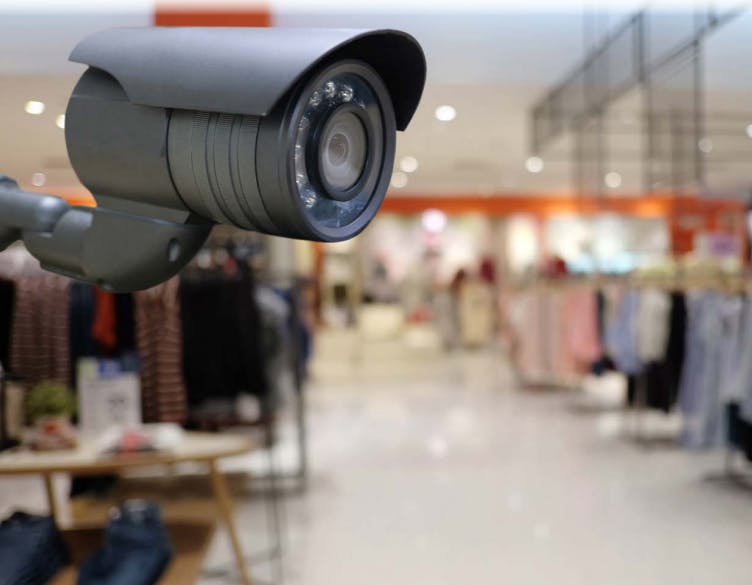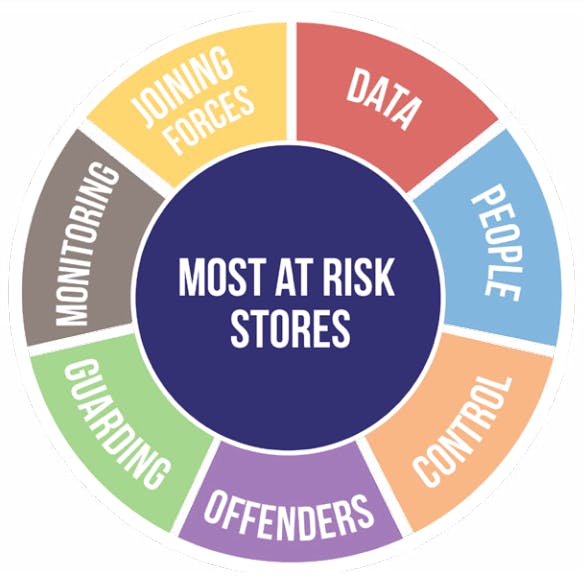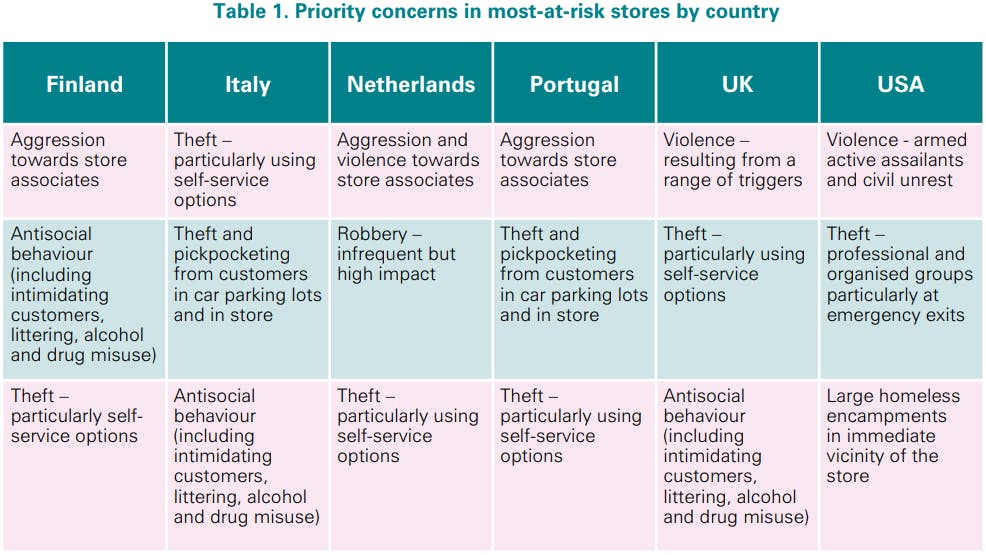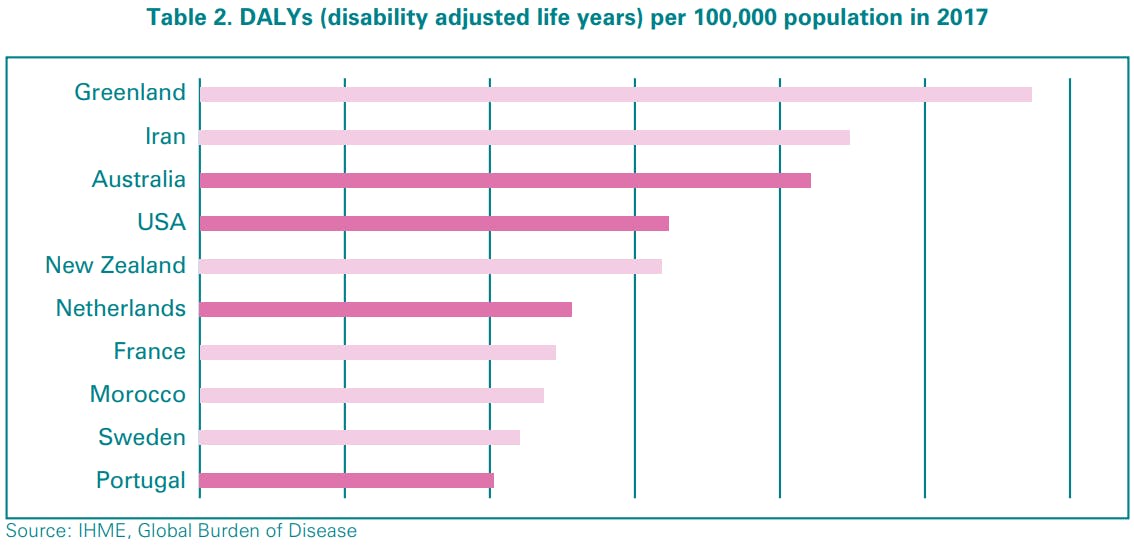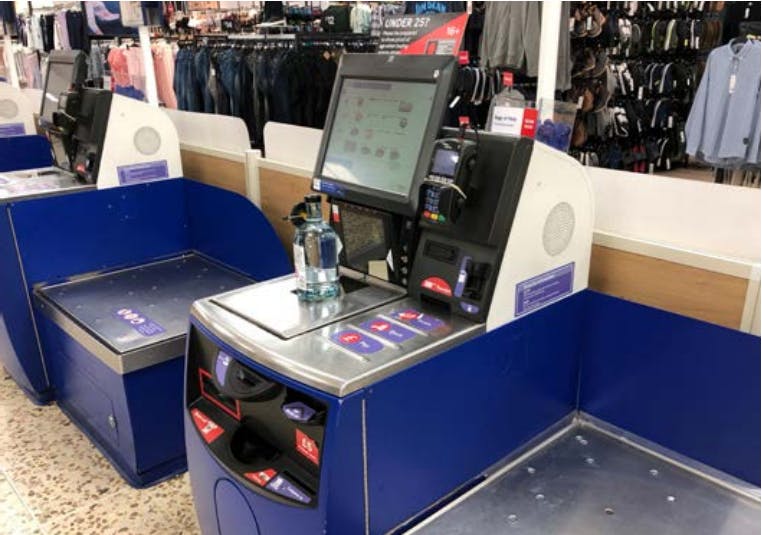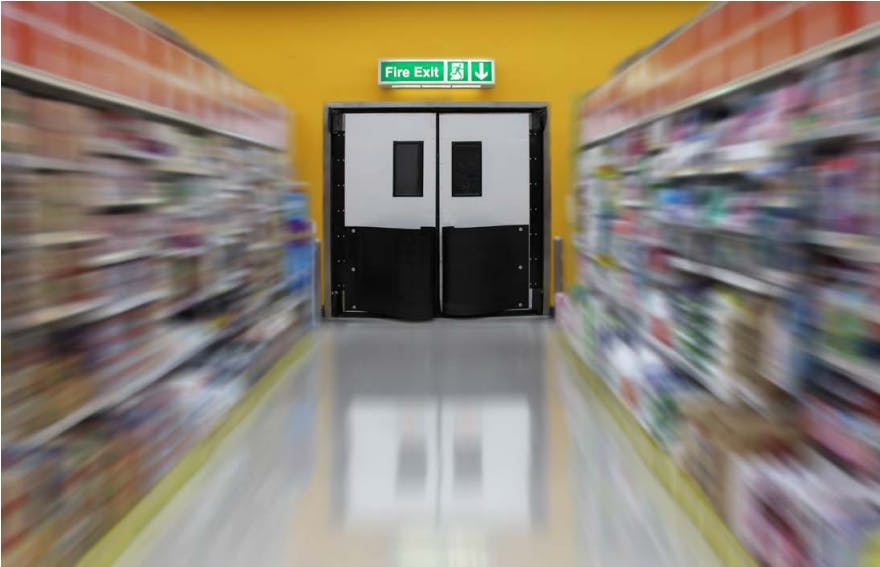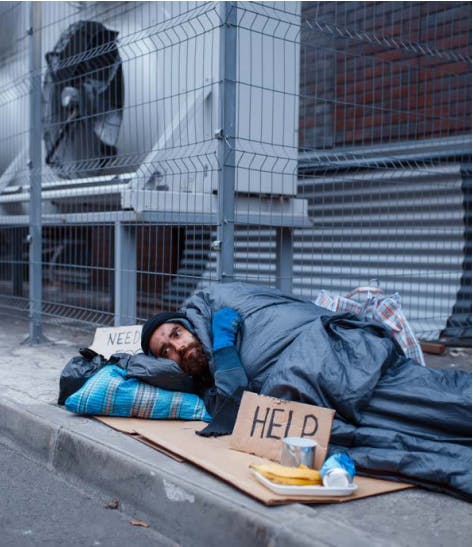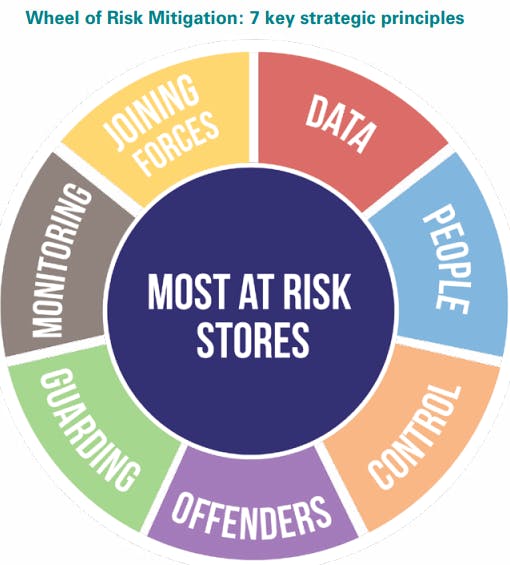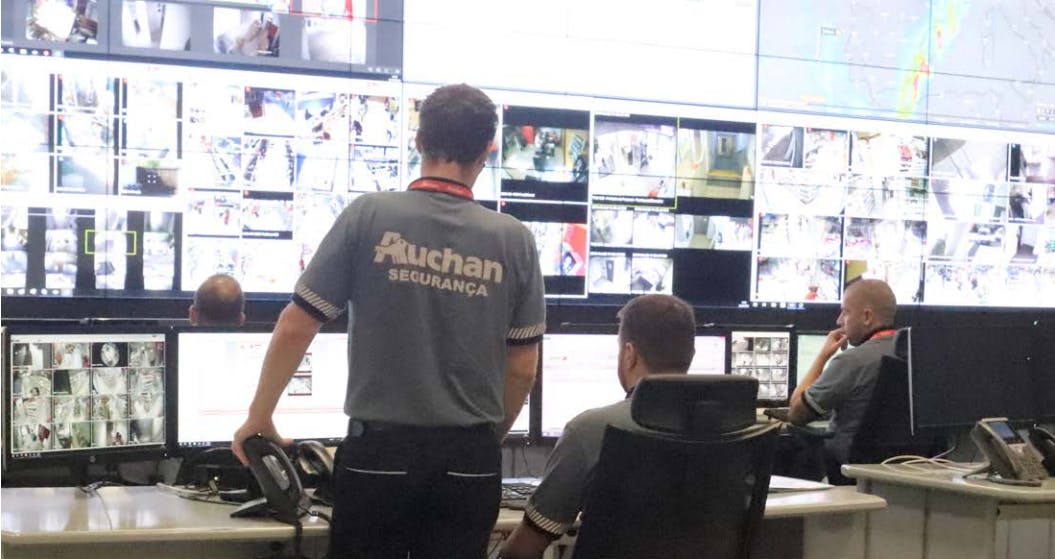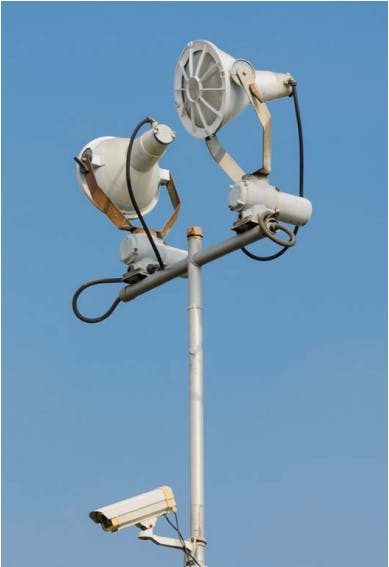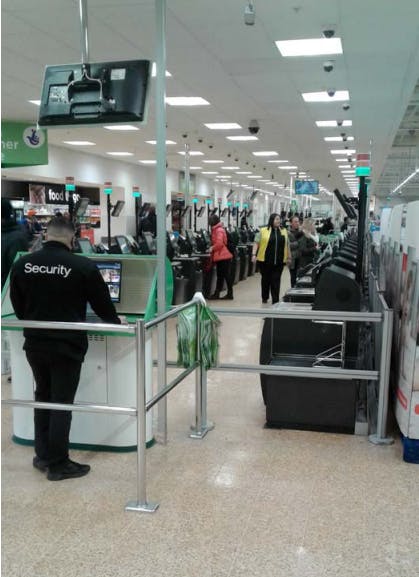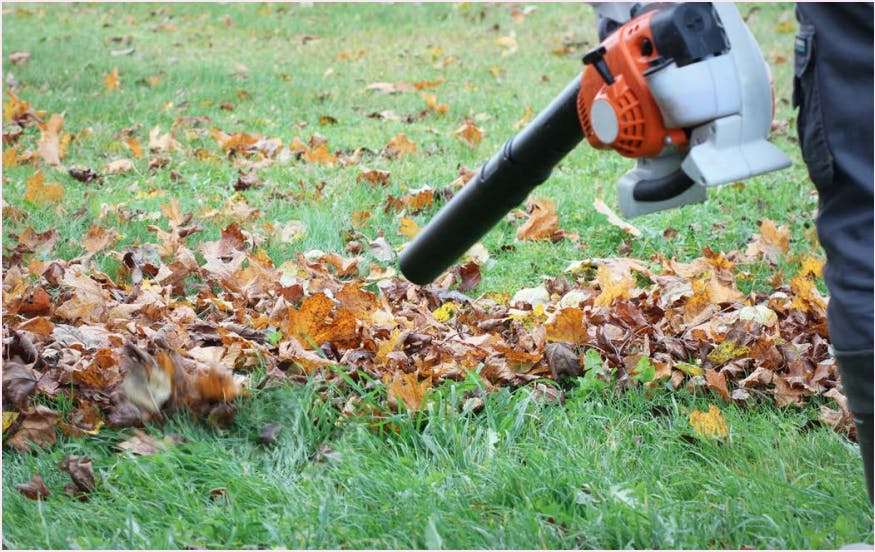Fortress Stores: Keeping the most-at-risk grocery stores trading
This research report outlines the findings from an in-depth study into ‘most-at-risk stores’, i.e. those with the highest rates of crime, threat and vulnerability. The project aimed to explore the risk mitigation strategies being deployed, their rationale, and how they are experienced by store associates.
Companies located in 11 different countries took part in interviews and more than 30 stores were visited in person in six different countries. Store associates, security guards, store managers, area managers, and even some customers took part in informal discussions and interviews relating to security and risk mitigation in each site. Initial findings were presented at international events and circulated to specific industry experts for comment. Feedback from these individuals and sessions has further helped shape this final report.
The research reveals that most-at-risk stores are typically comprised of intensified levels of the following:
- Violence and verbally abusive behaviour directed at store associates.
- External theft and theft from customers
- Homelessness, Transient Populations and Loitering
Risk Mitigation Wheel: 7 key strategies
The findings are presented as a framework designed to help retailers think about protecting their most-at-risk stores. The framework is comprised of seven elements: data, people, control, offenders, guarding, monitoring and joining forces. If nothing else, it is worth reflecting upon these categories; they might provide affirmation that your risk mitigation strategy is aligned with international approaches. Or they might just spark a new idea or approach to thinking about risk and how to counter it. The approaches in some locations are changing the mould and this might leverage engagement and support for delivering a successful risk mitigation strategy in some of the industry’s most challenging stores, particularly when it might be at odds with brand identity.
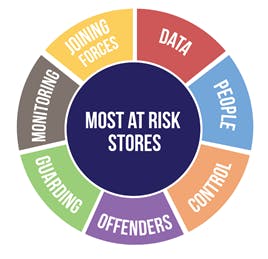
Although the tactics that sit within each of the 7 strategic principles might be different, the key point is about the extent to which the business is aware of risk, acknowledges the need to do things differently, aligns the different business functions, and enables specific actions to be taken.
- Awareness: To what extent is the store aware of the specific risks that are present?
- Acknowledgment: To what extent does the business acknowledge that the store requires special measures to manage the heighten risks?
- Alignment: To what extent has the business shifted practice to align with the security needs, particularly when this presents tensions with the overarching company brand and/or policy deployed elsewhere in the estate?
- Actions: To what extent is the business supporting and investing in concrete actions to mitigate risks?
A benchmarking tool is available for businesses to assess how well they are performing against the 7 key strategies and four levels of activity.
Foreword
We know that the current climate for bricks and mortar grocery stores is very challenging in some locations. This report documents in detail the many and varied issues that are present in and around stores; violence, verbal abuse, theft, organised retail crime, anti-social behaviour. It makes for a sobering read. But what is most illuminating about this report is its synthesis of how businesses are responding. There are strategies that are working to turn the tide on increased levels of violence and theft, but they involve creative thinking and sometimes tensions with the company brand. There are also areas identified where businesses could – and should – do better. Making it easier for employees to report incidents to the police and ensuring that accurate and timely data is collected, analysed, and acted upon is just one area where the industry could improve.
For those with responsibility for keeping colleagues safe and protecting assets, I strongly urge you to read this report, reflect upon the 7 strategies for keeping the most-at-risk stores trading and complete the Most-at-risk Stores Benchmarking Tool. It might be that some of the approaches are affirmative, some might not be possible due to local laws, but there might be some ideas or ways of doing things that are new. Additionally, the Benchmarking Tool might help to better identify where there are gaps, blockages and opportunities to evolve risk mitigation strategies and leverage engagement and support for delivering innovative strategies to combat risk.
I would like to thank Professor Emmeline Taylor for carrying out this research. With 11 countries participating, six of which were visited in person, it is by far the most comprehensive and in-depth study conducted on this important topic. I would also like to thank CAP Index for the additional research grant that made this study possible.
As with all the research undertaken on behalf of ECR Retail Loss, it would not be possible without the active support and involvement of the retail community and the many employees who generously gave their time to participate in the most meaningful of ways. Thank you for taking the time to share your thoughts and experiences – by working together we are much more likely to Sell More and Lose Less!
Finally, can I encourage you to not only read and share this study, but also take part in the work of ECR Retail Loss – further details can be found at: www.ecrloss.com.
John Fonteijn
Chair of the ECR Retail Loss Group
Acknowledgements
This research would not have been possible without the generous participation of the individuals who took part in interviews and their companies who agreed to host multiple store visits. I am also thankful to the many store associates, security officers, store and area managers, as well as customers who also contributed by taking part in informal interviews and discussions and sharing their insights and experience. All participants talked candidly about the issues that they face on a day-to-day basis. The research was made possible by an additional research grant provided by CAP Index. I would also like to extend gratitude to the 65 participants at an ECR Loss working group meeting in March 2023, the 128 attendees at the FMI Asset Protection and Grocery Resilience Conference in the USA in April 2023, and the specific industry experts to whom an earlier draft was circulated, for providing incredibly valuable feedback and discussion that has further helped to shape this final report.
Executive Summary
Background
Grocery retailers are facing unprecedented levels of in-store risks including frequent violent and verbally abusive attacks on employees and increases in the value and volume of thefts. These issues are occurring within a broader social context of a challenging economy, homelessness, drug and alcohol misuse and politically driven civil unrest that can lead to looting and criminal damage. Furthermore, there are ongoing difficulties in employee recruitment and retention. High vacancy rates and persistent staff turnover create additional problems. Experienced and trained employees are leaving the sector and recruitment remains challenging. Low levels of training and experience amongst new recruits, alongside understaffing only exacerbate the risks.
Although there are some positive examples of the police collaborating with retailers to tackle crimes affecting their business, overall, the view is that law enforcement is unresponsive to the issues and retailers describe feeling ignored and even “abandoned.” There are also many examples of criminal justice policies introduced with the good intention to relieve pressure on buckling systems but that bring with them unintended consequences for retail crime by effectively downgrading the seriousness of theft or allowing organised repeat offenders to avoid prosecution.
It is hard to think of a more challenging trading context for grocers and it is driving some stores to the brink of closure.
The research project
This research aimed to identify what security solutions (technological, design-based and humanistic) are being deployed by grocery retailers in their most-at-risk stores, i.e. those with the highest rates of crime; to explore the rationale for deploying the selected solutions from the perspective of Heads of Security/Loss Prevention, and; to gain an understanding of how the security response is experienced by store staff (in terms of usability, effectiveness, performance, issues etc.).
To meet these aims, an in-depth study was carried out that involved 25 interviews with 34 participants representing companies located in 11 different countries.2 Multinational in-person store visits were made to some of the most-at-risk stores identified by participating businesses. More than 30 stores were visited in person in six different countries.3 Store associates, security guards, store managers, area managers, and even some customers took part in informal discussions and ad hoc interviews relating to security and risk mitigation in each site. An initial draft of the findings was presented for discussion at an ECR Loss working group meeting in March 2023 attended by 65 retailers, circulated to specific industry experts for comment, and presented in the USA at the FMI Asset Protection and Grocery Resilience Conference in April 2023. Feedback from these individuals and sessions has further helped shape this final report.
Identifying the most-at-risk stores
Despite the growing range of risks present in-store, the research found very few businesses had a robust system for reporting, collating, analysing, and using accurate and up to date data to inform risk mitigation strategies. Even fewer were using data to predict the location of problematic stores or to enable the linking of repeat offenders across multiple locations. A lack of data not only makes it difficult to develop effective countermeasures, but it also hinders the ability to disrupt prolific criminal gangs.
Characteristics of most-at-risk stores
Grocers report that their key vulnerabilities and threats in most-at-risk stores are typically comprised of intensified levels of the following:
Violence and verbally abusive behaviour directed at store associates. The main scenarios in which this happens relate to encountering thieves and the enforcement of legislation relating to the sale of age-restricted goods and other prohibited sales. Less frequent but devastating is hate and ideologically motivated incidents (including armed active assailants) and robberies.
External theft in most-at-risk stores occurs at a heightened volume and frequency. Two types of theft are currently of particular concern: self-service checkout theft and emergency exit ‘push outs.’
Homelessness, Transient Populations and Loitering are major concerns in the most-at-risk stores. This can present multiple problems for retailers relating to littering, obstructing entrances and exits, aggressive behaviour, antisocial behaviour and signs of drug use.
Theft from customers, typically taking place in the parking lot, offenders use a range of distraction techniques to steal from customers and/or their vehicles. Some thieves operate inside the store, stealing personal items that have been left momentarily unattended in shopping carts.
While some issues are more pronounced in certain markets and rates of crime might vary by country, the increased cost of responding to physical security threats and vulnerabilities is universal. Not only are these costs incurred as a direct result of crime (stolen goods, lost working hours, criminal damage, etc.), but companies report that expenditure on security and preventative strategies is increasing across the sector.
How are businesses responding in their most-at-risk stores?
It is no secret that some businesses are permanently closing stores in their most-at-risk locations. High-risk and low-profit stores are balancing a need to protect people, assets, and reputation. This balancing act is not without tensions; there are social and political implications as well as reputational risks for security and operational decisions in some markets, particularly those in deprived neighbourhoods. The closure of stores in some locations can remove vital services such as medical supplies, contribute to unemployment rates, and even create ‘food deserts’ where local people cannot access affordable fresh produce within a reasonable distance.
A step back from permanent closure is a concerted effort to exert heightened levels of control over every aspect of the store operation using a mix of technology, design, operational strategies, and people. For some companies, applying a ‘fortress store’ mentality was a last attempt to keep trading in some markets that had become increasingly hostile. This includes changing trading hours, merchandise assortment, locking more produce away, tagging more products, enhanced and innovative guarding strategies, reconfiguring layouts and transforming store design. At times, the security strategy applied in most-at-risk stores was at odds with the broader direction of the company and its brand. There are difficult discussions taking place about how best to protect employees and assets while maintaining brand reputation and profitability
Strategies are not always straight forward or easy to implement across the estate. Big-box stores, retrofits and other formats are often not designed to be operated with the enhanced levels of control that is needed to manage high-level risks. There is no ‘one size fits all’ recipe.
Health and safety regulations and other legislation present additional challenges; prolific thieves take advantage of emergency exits to escape, employees are required to enforce a range of rules relating to public health and restricted goods (e.g. Covid-19 and alcohol laws) which can create ‘flashpoints’ for violence, and some thieves now flaunt their stealing to store associates knowing there is a ‘no challenge’ company policy in place.
Keeping most-at-risk stores trading: 7 key strategic principles
The findings are presented as a risk mitigation wheel designed to help retailers think about protecting their most-at-risk stores. The wheel is comprised of seven elements: data, people, control, offenders, guarding, monitoring, and joining forces. If nothing else, it is worth reflecting upon these categories; they might provide affirmation that your risk mitigation strategy is aligned with your current approaches. Or they might just spark a new idea or approach to thinking about risk and how to counter it. The approaches in some locations are changing the mould and this might leverage engagement and support for delivering a successful risk mitigation strategy in some of the industry’s most challenging stores, particularly when it might be at odds with brand identity.
Although the tactics that sit within each of the 7 strategic principles might be different, the key point is about the extent to which the business is aware of risk, accepts the need to do things differently, aligns the different business functions, and enables specific actions to be taken.
- Awareness: To what extent is the business aware of the specific in-store risks and vulnerabilities?
- Acceptance: To what extent does the business accept that the most-at-risk stores require special measures to manage the heighten risks?
- Alignment: To what extent has the business shifted practice to align with the security needs, particularly when this presents tensions with the overarching company brand and/ or policy deployed elsewhere across the estate?
- Actions: To what extent is the business supporting and investing in concrete actions to mitigate risks?
Most-at-risk Stores Benchmarking Tool
The Most-at-risk Stores Benchmarking Tool can be found on page 45. Businesses are encouraged to complete the tool by responding to a set of four statements for each of the 7 key strategic principles. The questions relate to the degree of awareness, acceptance, alignment, and commitment to act on issues experienced in most-at-risk stores.
The benchmarking tool will provide a score for each category (data, people, control, offenders, guarding, monitoring and joining forces) as well as across the four levels of activity: awareness, acceptance, alignment and actions, to provide clear insight to what aspects are working well and which require further attention.

Introduction
Retailers are facing multiple in-store security-related challenges and risks. Frequent violent and verbally abusive attacks on employees continue to be a major concern. This includes violence relating to theft; hate motivated incidents (including armed active assailants), robberies, and enforcing legislation relating to the sale of restricted goods (e.g. alcohol and bladed articles). Some challenges, such as theft, have always been a threat to contend with, but the volume and value of theft incidents has shifted gear as organised retail crime gangs mobilise efforts across states and countries. In addition, newer threats have emerged such as ideologically motivated attacks playing out in business environments, and civil unrest spilling over into stores resulting in looting, lost trading hours, and criminal damage. There are also many confronting social issues presenting in and around grocery stores that associates are typically ill-equipped to manage. For example, homelessness, drug and alcohol misuse, antisocial behaviour, and poor mental health within the community. A concentration of these risks is driving some stores to the brink of closure.
Research Aims and Objectives
Despite the heightened risks and the huge financial costs, there is relatively little shared knowledge about how retailers are responding to keep their most-at-risk stores trading. This report presents findings from a study that focused on understanding how grocers seek to mitigate risks in their most vulnerable locations, how they go about balancing profitability with a need to protect people, assets, and reputation, and, how store associates respond to interventions.
The research had three main aims, to:
- identify what security solutions (technological, design-based and humanistic) are being deployed by grocery retailers in high-risk stores, i.e. those with relatively high rates of crime (including theft, assaults against staff, and/or robberies) in multiple countries;
- understand the rationale for deploying the selected solutions from the perspective of Heads of Security/Loss Prevention, and;
- gain an understanding of how the security response is experienced by store staff (in terms of usability, effectiveness, performance, issues etc.).
Methodology
To meet these aims, a comprehensive and in-depth study was carried out with a total of 24 different businesses participating. The methodology involved the following:
- Interviews were conducted with 34 participants representing 24 companies located in 11 different countries.4 Interviews were conducted with a range of individuals and role types, including Heads of Security and Loss Prevention Managers.
- Multinational in-person store visits were made to some of the most-at-risk stores identified by participating businesses. The visits focused on observing firsthand the challenges that the store was experiencing as well as seeing the security strategies in situ. More than 30 stores were visited in person in six different countries (Finland, Italy, the Netherlands, Portugal, the UK, and the USA). Multiple businesses took part in some locations e.g. six different businesses participated in the USA store visits. Store associates, security guards, store managers, area managers, and even some customers took part in informal discussions and ad hoc interviews relating to safety and security concerns and risk mitigation in each site.
- Industry expert feedback. An initial draft of the findings was presented for discussion at an ECR Loss working group meeting in March 2023 attended by 65 retailers, circulated to specific industry experts for comment, and presented in the USA at the FMI Asset Protection and Grocery Resilience Conference in April 2023 attended by 128 delegates. The valuable feedback from these individuals and sessions has further helped to shape this final report.
- Literature review. A comprehensive review of available industry reports and academic research published in the English language was undertaken. Businesses from 8 non-native English-speaking countries participated in the project. We have tried to incorporate as many examples of data from these countries as possible but it is often not readily available. It should also be noted that often the data underpinning non-academic reports is not available for scrutiny and therefore the robustness of the claims, particularly relating to the frequency and volume of crime incidents, should be taken with caution. This caveat further underscores the need for businesses to collect the most accurate, detailed and timely data as possible.
Structure of the report
The following section, ‘Most-at-risk Stores: risk and threat priorities’, outlines the main issues experienced in most-at-risk stores. While some of these concerns might also be present in lower risk stores, the emphasis here is on the frequency, volume and scale which catapults the store into the ‘most-at-risk’ status.
Section 3, ‘Fortress Stores: keeping the most-at-risk stores trading’ outlines a snapshot of the approaches being taken internationally to respond to different risks in the grocery sector. The findings are presented as a framework comprised of seven elements: data, people, control, offenders, guarding, monitoring and joining forces. They represent the top-level tactics and approaches applied in the most-at-risk stores and locations. Again, some of these approaches might be very familiar in some locations, others might not be possible due to the legal context, but overall, as a framework, there were very few businesses that were actively adapting in all seven areas. The Most-at-risk Stores Benchmarking Tool on page 45 enables businesses to explore how they are performing across the 7 key strategic principles.
It is important to highlight that the law is different in each country (and sometimes across jurisdictions in the same country). This goes some way to explaining the varied deployment of security solutions, particularly pronounced for audio-visual technologies such as body-worn cameras (BWC), and facial matching. There are also cultural differences which underscore customers’ tolerance of and appetite for different security procedures and technologies. Furthermore, the research did not set out to establish the effectiveness or ROI of each technology or process beyond a company’s own perception of it. Rather, the aim is to document the approaches being taken across the international landscape to provide affirmation, inspiration, and leverage to support difficult conversations within businesses.
Most-at-risk Stores: risk and threat priorities
I have never seen levels of theft as high as they are now. When the offender no longer cares if you see them stealing or not or they think the risk is worth the reward, that is a scary place to be. Companies are having to take more and more extreme measures. In some locations they are deciding not to stock some merchandise, or the cost is being driven up because the losses are so high. Some companies are closing stores entirely. That means that those communities have nowhere to go to buy their medicines, their groceries, etcetera.
(Assets Protection Senior Manager, national retailer, USA)
As outlined previously, we know that retailers are experiencing multiple and varied in-store security-related challenges. We asked grocery retailers to identify their top three concerns in their most-at-risk stores (see Table 1). Perhaps unsurprisingly, the safety of employees was the leading concern in most countries. All participants described an environment that was becoming increasingly hostile and one in which employees were experiencing heightened levels of violence, aggression, and verbal abuse. Concerns mostly related to guest-on-associate violence, the main triggers for which are explored below, but also other specific violent threats such as active armed assailants (particularly in the USA) and civil unrest (particularly France, the USA, and the UK to a lesser extent) which could manifest in looting or protests within the vicinity of the store.
Other prevalent risks identified as priority concerns included theft, particularly self-service checkout theft and emergency exit ‘push outs’; the issues generating by loitering, antisocial behaviour and large homeless populations congregating in and around the store; and theft from customers while on the premises (often associated with professional travelling thieves rather than opportunists). These four main concerns are outlined in more detail below.
Violence and Aggression
Violence can be customer on customer, customer on team member, team member on team member or some other factor in a team member’s life that could play out in the workplace where the potential attacker could be coming to the workplace to cause harm.
(VP Asset Protection and Safety, regional retailer, USA)
Multiple sources suggest that the frequency and severity of violent incidents in the retail sector have been increasing significantly.5,6 While this trend does not manifest in precisely the same way in each country, the overall perception is of an ever more aggressive working environment, particularly in densely populated urban areas.
Some of this increase was attributed to what was referred to as ‘organised retail crime’ (ORC) but it is important to note that there are different definitions internationally as to what constitutes ORC (see textbox below). Participants in this study described organised criminals as being more brazen, more willing to use violence, and more confrontational than other types of offenders.
In addition, there are other factors that are contributing to an increase in violence including a corresponding growth in opportunist theft, active armed assailants, gun and knife violence, and the requirement for store associates to uphold legislation and regulations associated with restricted items e.g. age-related sales, bladed items, alcohol and tobacco.
I’ve had people scream in my face because I accidentally rang an item twice.
(Store Associate, USA)
The threshold has definitely lowered for the use of violence.
(Chief Risk Officer, Finland)
Demonstrating the triviality of some situations that result in violent altercations, some shop workers reported that customers would become violent or abusive if merchandise was out of stock, they had accidently been charged the wrong amount, or other services in the store, such as ATMs, lottery machines, or bill paying facilities, were not functioning.
Organised Retail Crime: A note on definitions
There are different definitions of organised retail crime used internationally. For example, in some countries two or more persons stealing with the intention of selling on merchandise for financial gain is regarded as ORC. Whereas in other locations ORC is used to refer to largescale criminal enterprises that use techniques of criminal exploitation7 to force victims, usually vulnerable adults and children, to steal.
The scales of operation in these two descriptions are vastly different and the involvement of organised criminals in other activities such as trafficking, drug dealing, and modern slavery also sets them apart.
There is much more that needs to be done to establish universal working definitions of what ORC is, and how it manifests, if it is to be effectively targeted and disrupted.
The main triggers and scenarios in which violence occurred, as reported in this study, were:
- encountering thieves
- enforcing legislation relating to the sale of age-restricted goods and other prohibited sales
- hate and ideologically motivated incidents (including armed active assailants)
- robberies (including ‘flash mob’ robberies and ‘swarming’)
- mental health issues
Encountering thieves
Shop thieves are increasingly resorting to violence, threats, intimidation, and abuse directed at staff. Being challenged or apprehended for shop theft was identified as one of the main triggers for violence and verbal abuse. Importantly, a store associate might not actively be trying to intervene in a theft incident but unintentionally be in the way of a criminal trying to escape. Some businesses have responded to growing levels of violent attacks against store associates with “no challenge” policies that are enforced with disciplinary procedures should an employee contravene them. Some associates that took part in this study were not supportive of blanket policies which they felt undermined their ability to assess potential risk and disempowered them. Furthermore, some reported that offenders would brazenly taunt them by openly stealing knowing that they were unable to respond.
There is a strong relationship between substance misuse, shop theft and the use of violence and aggression by drug-affected offenders. Offenders who are desperate not to be detained through fear of withdrawing from drugs can become volatile and threatening. It was estimated in the UK in 2018 that approximately 70% of shop theft was committed by frequent users of heroin, cocaine or crack cocaine.
Enforcing legislation
Another flashpoint for violence and aggression is upholding restricted sales on merchandise such as bladed articles, acids, alcohol and tobacco products. It has been estimated that more than 1 in 5 violent attacks on shop staff are triggered by age-restricted sales.9 There are also some voluntary codes applied by retailers to restrict the sale of some products. For example, some companies as part of their social responsibility mandate, have imposed a voluntary ban on the sale of “energy drinks” to under-16s. Customers wishing to purchase these products might also be asked to present proof of age documentation. It has been reported that the voluntary codes can create tensions between store associates and customers, particularly where there is no legal reason to deny the sale. Similar issues have also been raised in relation to the reduction in single use plastics in some countries. Customers using their own bags can provide an opportunity for theft.
Hate and ideologically motivated incidents (including armed active assailants)
Hate and ideologically motivated attacks can take two broad forms: ‘hate motivated incidents’ or ‘ideologically motivated attacks’ that seek to gain attention for a particular cause or in response to a specific incident.
Hate motivated incidents
Hate crimes are defined as ‘any criminal offence which is perceived by the victim or any other person, to be motivated by hostility or prejudice based on a personal characteristic. Although hate crimes are defined differently in different countries, some of the protected characteristics typically include race, religion, disability, sexual orientation and gender identity. Shop workers frequently experience challenging customers, but few incidents are as distressing and difficult to manage as personal attacks that aim to maximise hurt and humiliation – particularly when it occurs in a busy shop setting in front of customers and colleagues. This type of abuse can often take place over a prolonged period of time and can be particularly traumatic for victims.
Ideologically-motivated attacks and armed active assailants
Domestic terrorists and active assailants have targeted transit systems, schools, hospitals, as well as retail stores and/or shopping malls. They can be acting on a range of violent ideological motivations, including racial or ethnic hatred as well as anti–government attitudes. Active assailants might be motivated by a single issue (such as far right extremism) or a combination of ideological influences. In some instances, they might be acting in response to a personal incident of perceived humiliation, feelings of social exclusion and low social capital. Perpetrators might also develop their own distinctive justifications for violence that are difficult to categorise. The range of ideological influences and the idiosyncratic ways they manifest make these attacks difficult to predict. They can take on a variety of forms from lone actors and small groups of informally aligned individuals to networks who target violence toward specific communities.10 Although concentrated in the USA, these incidents also occur in other countries. For example, a 22-year-old gunman armed with a rifle killed three people and injured another four at a shopping mall in Copenhagen, Denmark in July 2022.
Robberies, ‘flash mob’ and ‘swarming’
The reality is that any business with cash or high value items on the premises can attract the attention of criminals. Robbers deliberately employ strategies of violence to force victims to hand over money, cigarettes, alcohol and other goods. Robberies can be particularly scary and intimating for store associates who might be physically hurt or threatened. Often demands are made of them that can be difficult to fulfil under duress, such as opening cash tills and safes or removing security tags.
Most robbers are armed with some form of weapon; knives, firearms, machetes, hammers and syringes are not uncommon. The most used weapon varies by country but it is typically a firearm or knife. Robberies are particularly volatile situations, particularly when offenders are under the influence of drugs or heavily intoxicated.
Due to a range of new security measures and situational crime prevention strategies that have become more sophisticated and widely available, armed robbery has changed significantly in the past two decades. Reflecting target displacement, armed robbers have turned their attentions to ‘softer targets’ as banks have installed sophisticated security that is too difficult for the average criminal to defeat. Convenience stores, service stations, liquor stores, and supermarkets (particularly those with pharmacies) are now experiencing more robberies.11 Participants also described concerns relating to multiple offender crimes such as ‘flash mob’ or ‘swarming’ robberies where a group of participants, often masked, enter a retail shop or convenience store en masse and steal goods. In these types of incidents, the number of individuals participating in the robbery and their apparent willingness to use violence can quickly overwhelm store associates and security guards. Aside from ad hoc media reports, there is very little reliable data to determine the prevalence of this crime type, but it was referred to in several interviews as an example of how offenders are becoming more brazen and aggressive.
Mental health issues
According to the Institute for Health Metrics (IHME) approximately 13% of the global population suffer from some kind of mental disorder. One way of measuring the prevalence of mental health issues in a population is to look at the disability adjusted life year (DALY) – a sum of all the years of healthy productive life lost to illness, be it through early death or through disability. As Table 2 illustrates, four of the countries that participated in the present study are in the most recent published top ten countries most burdened with mental illnesses.
This is not to suggest that those with mental health issues are more likely to offend, but it illustrates a range of societal issues that might impact upon a public-facing business. The data compiled by the IHME precedes the Covid-19 pandemic and the economic downturn experienced in many countries. These issues were highlighted by participants as further contributing to theft and violence in most at-risk stores.
During the COVID-19 crisis, shop workers experienced increased levels of violence and verbal abuse directed at them. As customers became agitated by restrictions, queues and limits on stock, some directed their frustrations at public-facing employees such as shop staff who were working hard to serve their communities.
COVID-19 triggered a lot of aggression in all countries, towards staff and between customers.
(Security Expert, multinational, Europe)
During COVID, there was an explosion in the number of aggressive incidents reported - 150% on top of the regular numbers. Why? Because not that many customers were allowed to visit the store, they had to wait in line outside and sometimes in the rain. And of course, they are disappointed, and they are faced with a lot of new regulations. Then they started arguing and fighting and sometimes spitting. The number of incidents reported before COVID was around, say, 15- 20,000 incidents a year. And in peak moments of COVID in the entire year of 2020, it was around 50,000 incidents: more than double.
(Security Manager, the Netherlands)
The COVID-19 pandemic has had a severe impact on the mental health and wellbeing of people around the world. At the same time access to mental health services has been severely impeded. Many retailers recognise that violent incidents triggered by the mental health impacts of the pandemic continue.
Pre-COVID we would average one new threat of violence per day. During the two big years of COVID that number went up 50%. We are now 50% higher in 2022 than what we were last year. I don’t know if COVID is the driver. There’s a correlation there but I don’t know if it’s causational. Mental wellness is by far and away the highest contributing factor. There is correlation to COVID, there is correlation to organised retail crime and, in the US, there is also correlation to having access to guns. They are all correlated factors that increase risk in our stores.
(VP Asset Protection and Safety, USA)
The impact of violence and aggression on employees
The impact and consequences of violence can result in life-changing injuries and even fatalities. The industry report, It’s Not Part of the Job, focused on capturing the everyday experiences of violence and abuse that store associates endured.13 It revealed frequent instances of employees suffering broken bones, being punched, kicked, stabbed with knives, lacerated with smashed bottles, and sustaining permanent sight loss through in-store assaults. Yet the impact of violence and verbal abuse stem far beyond physical impacts; violent encounters can result in long-lasting and life-changing emotional and mental health consequences for victims. Retailers in this study highlighted that it is not just a store associate’s physical health that can be impacted by aggressive behaviour, but often their mental health and psychological wellbeing.
Our first concern is our team member’s psychological safety. That’s number one by far. What we’ve noticed in these challenging markets is coming into broken windows and boarded up windows and graffiti and that kind of stuff. Or seeing the number of boosters and thefts, it takes a toll on them mentally where they see it every day.
(AP Senior Manager, USA)
For frontline employees, working in a grocery store presents an increasingly aggressive environment which can impact on their mental wellbeing. It is not surprising that The Retail Trust’s Health of Retail report (2022) found the rate at which retail workers want to leave the industry is consistently higher than for workers across other sectors.
External theft
In addition to concerns relating to violent assaults against employees, is the high volume of theft. This has reached a level so severe in some stores that shop workers describe it as ‘soul destroying’.15 The nature of retail theft is changing. It is no longer ‘just’ individuals stealing for personal use or to fund a drug habit. These offenders are still active, but they have been joined by professional criminal gangs who steal with the express intention of reselling stolen merchandise at scale (see textbox on Organised Retail Crime on page 7).
Industry research in the UK suggests that the majority of thefts committed against retail businesses (79%) are by repeat offenders that are not being sufficiently tackled by the police.
We know about 10% of our offenders are responsible for 66% of our ORC losses in stores.
(Loss Prevention Manager, multinational retailer, Australasia)
ORC theft is a major issue particularly in defunded states. There are no consequences in some states. The police stance is that if no one is injured then they are not coming. We have complete inability to combat ORC in those states, so we end up turning the criminals loose.
(Senior AP Manager, USA)
Although overall, the participants relayed that ‘grab and run’ continues to be the most frequent modus operandi for thieves, there are multiple techniques that are used by shoplifters. Three issues were repeatedly flagged as being of particular concern for retailers: theft via the self-service checkout, emergency exit ‘push outs’, and theft from customers.
Self-service checkout theft
Self-service theft continues to be a major source of theft in the grocery sector. A recent report published the ECR Retail Loss in 2022 found that survey respondents estimated that SCO systems accounted for as much as 23% of their total unknown store losses, with malicious losses representing 48%.17 Furthermore, two-thirds of respondents were of the view that the problem of SCO-related losses was becoming more of a problem in their businesses (66%). The present study found that some stores were rolling back the number of self-checkout stations due to high losses:
“ SCO systems accounted for as much as 23% of their total unknown store losses, with malicious losses representing 48%”
We started with self-checkout. We have over a hundred stores now with self-checkout. We stopped the rollout. We’re even rolling back some stores, so the self-checkout is taken out, normal cash registers are reapplied. The losses are just crazy. If you’re working on a normal cash register and somebody buys a bucket, you have to look inside it. Is it just one bucket, or is it filled? But at the self-checkout, people can just put everything inside and scan the bucket. We don’t have weight scales, but we are piloting the cameras to try and solve it. If not, self-checkout is “done”.
(Security Expert, Europe)
However, despite these huge losses, the dominant direction of travel found in the present study is towards more self-service provision with some grocers embracing a fully self-service model, particularly in their smaller format stores.
65% of all our transactions are finished at the self-checkout. We believe in the instrument of self-checkout; we want to go to 100%.
(Security Manager, the Netherlands)
As self-service provision evolves to include ‘scan and go’ and trolley checkouts alongside the more established model, the complexity of issues this presents for accidental losses and deliberate theft becomes more complex.
Emergency Exit ‘push outs’
A growing trend that several retailers identified as a concern in most-at-risk stores was the use of emergency exits for thieves to run from the store with stolen items. Thieves would either carry the stolen items or fill a shopping cart and then push that out of the emergency exit. An Assets Protection Senior Manager for a national retailer in the USA outlined the severity of the problem:
We had one store that had 56 fire exit push outs in one day and 153 in a week. Nobody wanted to come into work.
(Assets Protection Senior Manager, national retailer, USA)
Emergency exits are required by law to allow staff and customers to escape quickly and easily in an emergency such as a fire or an active assailant. Exit doors must not be locked or fastened in a way that they cannot be easily and immediately opened by any person in an emergency. This makes them a useful means of escape for criminals. Some retailers were responding by stationing a member of staff at emergency exits located near high value goods. This potentially offered some deterrence to the less brazen thief, but store associates reported that at this point most thieves had already committed to steal and would still run through the exit with the stolen goods.
Theft from customers while on the premises
Theft from customers was identified as a major concern for several retailers, particularly for retailers in Italy, Portugal and the USA. While this can and does occur in any location, in most-at-risk stores this was specified as a persistent problem.
Typically, thefts occurred in the parking lot. Security experts reported that offenders would often deploy a range of different distraction techniques. These included placing a shopping cart behind the customers vehicle so they would have to get out of the car at which point the offender would grab any valuable items within reach and tell the customer they had dropped something and then stealing from them when they diverted their gaze. Offenders also pickpocketed customers while they were in store, often taking advantage of handbags and valuable items being left in the shopping cart.
In terms of impact to the customers, the worst one is probably pickpocketing. Because these have an impact for the customer that is very bad, when it happens the customer holds us responsible for that, because it’s happening in our store.
(Security Manager, Italy)
Antisocial behaviour, homelessness, and loitering
Many retailers, particularly in high density areas, report issues with anti-social behaviour (ASB). This typically takes the form of groups of people congregating, committing criminal damage, graffitiing, or intimidating customers.
We have problems in terms of the type of people that are present in the area, that often are not so easy to manage. Like drunk people for example, we have some areas where they use our entrance to sit down and to drink, after they probably have stolen the wine from our stores.
(National Head of Safety and Security, multinational retailer, Portugal)
In addition, retailers report a growing problem with individuals who are homeless spending extended time in the immediate area outside their stores or stealing basic items for subsistence. In some locations, there might be a handful of homeless people who have identified a place to sit or sleep in alleyways, store entrances, or in the parking lot outside the store but in other locations, particularly in parts of the USA, large semi-permanent encampments have been established.18 This can present multiple problems for retailers – just some of the issues reported included littering, aggressive begging, obstructing entrances and exits, public urination and defecation, and signs of drug use.
Participants in this study were very sympathetic to the issues facing homeless people and want to see better service provision. However, they articulated frustrations with local governments to address the problem and voiced concern that the problem was only going to get worse post-pandemic and faced with economic downturn in many countries.
We’re seeing an incredible amount of homelessness and transient populations in a lot of these dense, urban areas. It’s making it difficult to run businesses in some of these locations. One of our stores has an entire homeless encampment right behind the store and the authorities are fine with it. They said they can have up to 50 tents there and when I say behind, I’m talking ten feet behind our store. So, as you can imagine, there’s a lot of drug abuse there. There’s a lot of things going on and what’s sad is that often times they’re not the violent people. From the stuff you see it’s mental illness, and drugs. So, that’s been a really challenging thing for us to figure out how to operate in that environment. (
AP Senior Manager, USA)
Summary
This section has outlined the main concerns that retailers are experiencing in their most-at-risk stores. While these factors are by no means unique to these stores, what sets the most-at-risk store apart from the rest of the estate is the sheer volume, severity, and frequency of criminal attacks against the store, its employees, and its customers.
By providing greater detail on the way in which risks are currently manifesting, it is hoped that businesses will be better equipped to recognise emerging issues in their own stores and respond swiftly. The following section outlines 7 key strategic principles that grocery retailers are deploying in their most-at-risk stores to tackle these threats and vulnerabilities. They represent the top-level strategies and approaches applied in the most-at-risk stores and locations. As mentioned above, some of these approaches might be very familiar in some locations, others might not be possible due to the legal context, but overall, as a framework, there were very few businesses that were actively adapting across all seven areas.
Keeping the most-at-risk stores trading: 7 key strategic principles
It’s not about immediacy but rather a strategy to stabilise and neutralise that environment over a period of time.
(VP of Assets Protection and Safety, USA)
This report focuses on the most-at-risk stores, i.e., those that occupy the highest level of concern for businesses. The previous section outlined the top-level concerns in these stores to paint a picture of the day-to-day problems encountered. Typically, a most-at-risk store will be characterised by frequent incidents of violence, verbal abuse, increased theft of merchandise (by volume and value), theft from customers, antisocial behaviour, and a range of social issues, such as homelessness and mental health, that present additional layers of operational risk and complexity.
Different terminology and scales are used to describe most-at-risk stores. Some companies had simple binaries of what they termed ‘basic stores’ (low risk) and ‘focused stores’ (high risk), whereas others had more disaggregated categories with up to a 10-point scale of risk. Furthermore, some companies were found to have separate registers for different types of risk e.g., for loss, food waste, or violence. Overall, most appeared to operate with – or be moving towards – a scale comprised of three or four risk ratings along the lines of ‘low risk’, ‘medium risk’, ‘high risk’ and some adding an additional category along the lines of ‘ultra-high risk’. There is a base level of security solutions that are common to most large grocery companies such as CCTV and electronic article surveillance (EAS); this section focuses on the cross-cutting principles that sit above the specific tactics.
It is important to remember that, at times, the strategy being pursued in these stores is at odds with the broader direction of the company and its brand. For example, putting products in locked cabinets that require a store associate to unlock them. There are difficult discussions taking place about how best to protect employees and assets while maintaining brand reputation and profitability. Although the tactics that sit within each of the 7 strategic principles might be different, the key point is about the extent to which the business is aware of risk, accepts the need to do things differently, aligns the different business functions, and enables specific actions to be taken.
- Awareness: To what extent is the business aware of the specific in-store risks and vulnerabilities?
- Acceptance: To what extent does the business accepts that the most-at-risk stores require special measures to manage the heighten risks?
- Alignment: To what extent has the business shifted practice to align with the security needs, particularly when this presents tensions with the overarching company brand and/or policy deployed elsewhere across the estate?
- Actions: To what extent is the business supporting and investing in concrete actions to mitigate risks?
1. DATA
Data is an important part of any risk strategy. After all, what gets measured gets managed. Some of the important uses of in-store incident data include:
- identifying new and emerging issues and risks
- identifying ‘travelling’ offenders operating at multiple locations across the estate
- signalling to offenders that their actions are noted, recorded and action is being taken
- reducing costs by ensuring that finite resources are targeted and efficient
- engaging with other businesses on shared concerns
- generating enhanced ‘buy in’ from law enforcement
- creating a risk model
- monitoring the impact and effectiveness of security solutions and strategies
- reassuring employees and allowing for successes to be celebrated
Despite the many ways that accurate data collection and analysis can help a business to manage risk, there was a lot of variation observed in this project. Although some businesses had a robust data collection and analysis process in place, these were the exception. It was acknowledged by several participants that internal data collection needs improvement; too many incidents go unreported due to the volume, a lack of staff time, and a lack of confidence that it will result in any action being taken by law enforcement and/or senior management.
There is a lot of potential to gather data so that we can gain more visibility of the issues. We can also analyse the impact of what we are doing.
(Chief Risk Officer, Finland)
Incidents are reported to a third-party provider and their analysts join the dots in the background. The more information they can feed in from retailers and the police, the more powerful it is.
(LP Manager, Australasia)
Retailers need to identify not only what their risks are, but also where they are most concentrated to enable the efficient targeting of resources.
Our critical shrinkage stores are not the same as our critical security stores. Sometimes you do have quite a lot of overlap, but sometimes you might have some really distinct stores that don’t have both issues, so our safety and security deployment principles are specific to the data. You might have a shop that has really bad anti-social behaviour and a really bad shoplifting problem, but it never suffers from a robbery. This informs which tools to roll out.
(Head of Security, UK)
It was clear from the interviews that accurate data was providing insights into cross-store prolific offenders. For organised or travelling offenders, having a team of investigators and analysts was revealing trends that otherwise would not have been picked up on. In these scenarios, businesses were centralising the security function to identify and respond to repeat prolific offenders.
Our resources to protect a store are exclusive to that store but organised retail crime (ORC) is agnostic to location. We have a special investigative team for ORC that is centrally managed out of the corporate office. They can work across multiple jurisdictions and are aware of how the laws vary state to state. So, for ORC we centralise the process.
(Head of AP and Safety, USA)
We’re typically quite tailored to stores or groups so we needed someone to centrally manage the offenders that work right across the UK. We knew we had offenders and gangs that would be popping up all over. So when they are identified as a prolific offender across different areas that case will go to the Crime Team who then work with the police to drive prosecution. They will go to the police and go ‘here’s 50 case files of this offender, go and prosecute them’. We’ve had some really great successes.
(Head of Security, UK)
Some companies are responding to the need for comprehensive data by making internal reporting more streamlined. For example, by introducing mobile devices and apps to enable instant reporting in situ. These can have multiple functions including the ability for mobile POS and communication through instant messaging to colleagues. Poor data collection severely limits the ability of businesses to conduct analysis that could help to bring awareness across the estate about new and emerging crimes. None of the above uses of data are possible without analysis – and this starts with accurate and timely incident reporting. There are certainly opportunities to mitigate risk being missed due to incomplete data recording. Businesses need to better support staff by providing them with the time, software and devices required to report crime.
Risk modelling
Participants described different methods for using the data collated to model the location, frequency and nature of risks. These can broadly be categorised into three main types based on the data they use:
Internal data only. Typically, this risk model would comprise of the number of incidents of customer theft, robberies, break-ins, vandalism, and aggression towards store associates.
Integrated internal model. A risk model devised and managed by an internal analyst that combines internal data (i.e., number of incidents) with externally available data such as police recorded crime, demographics and employment rate.
Integrated external model. A third-party designed and managed risk model that integrates storebased data with a range of other variables including socio-economic indicators, crime rates, the presence and concentration of crime generators (e.g., transport hubs, licensed premises) and potential crime inhibitors (e.g. police stations).
We are developing a sort of ranking, based on the number of events (e.g., stealing) that are recorded in the store due to the presence of our loss prevention specialists. We use the indicators to decide where to put more internal resource, such as loss prevention specialists, or to target external activities, such as pickpocketing.
(Security Manager, Italy)
We spend a lot of time understanding the environment we operate in and how to neutralise it to make it feel safe. We look at crimes against persons in the community that could show up within our buildings, so that could be threats of violence, shootings, stabbings, things of that nature. And also, crimes against property, but more retail-centred, so risk of theft, burglaries, robberies, any armed activities, etc. We use an external provider for that, and we throw some internal factors into it e.g., stability of the workforce.
(VP of Asset Protection and Safety, USA
We generate a store performance profile which uses about 100 metrics currently to establish a benchmark. We are still working through which indicators have historically been underutilised and which ones don’t actually tell us much. But we know that internal behaviours are important for helping loss prevention to deal with the issues. Relating it to theft there are definite accountabilities that ‘smart leaders’ deal with better so we look at the tenure of the leadership team. They help to mitigate circumstances that can lead to loss. Team experience is important; a lot of indicators come down to how engaged the store team is.
(LP Manager, Australasia)
We draw upon external factors such as the average wages in the area, the unemployment rate, stuff like that. And we make good use of internal factors such as stock losses. We register all types of incidents at store-level, and we collate that in the dashboard and use it to make a security plan for that store.
(Head of Security, the Netherlands)
Any risk model is only as good as the data that is entered into it. Related to the issue of under reporting above, participants in this study described concerns about the validity, reliability, and timeliness of data, both internal and external, that could skew risk registers. In addition, some felt that there was not enough understanding about which variables had the strongest explanatory or predictive power, how to effectively weight variables (i.e. weighting high-risk/low-frequency incidents such as armed robbery compared to low-risk/high-volume incidents such as theft), and how to control for variables such as store format (e.g. convenience, large format, petrol filling station shops, acquisitions/purpose built, etc.).
2. PEOPLE
During the fieldwork, one retailer told me that according to their risk modelling, they had a store that on account of multiple metrics, should have been one of their most-at-risk locations. Yet, it was one of their best performing stores. Investigating further, they found out that a local drug dealer’s mother was employed as a manager of the store and so it was largely considered to be ‘off limits’ for any criminal activity. Of course, not every high-risk store can employ relatives of the local criminals, but there is a bigger insight here and it’s about the power of people to protect a store, its assets, associates and customers.
Investing in and empowering employees
The previous section highlighted low staff morale and despondency across the retail sector. Associates need a reason to believe that they can win against thieves and aggressive customers. This includes investing in meaningful and bespoke training, so staff feel equipped to deal with criminal events and challenging issues, as well as providing them with equipment to enable them to quickly report incidents, communicate, and feel protected.
Companies are recognising the need for store associates to be in instant and ongoing communication with one another to quickly identify and respond to risk, particularly in locations where the volume of criminal activity is high, and events unfold quickly. Wireless headsets for store associates were observed in several stores. These were reported to have multiple benefits including improving colleague safety. Employees can communicate in real time to alert other staff members and security if a customer is becoming aggressive. In addition, they can discretely share information about suspicious behaviour or known criminals entering the store. The previous section highlighted low staff morale and despondency across the retail sector. Associates need a reason to believe that they can win against thieves and aggressive customers. This includes investing in meaningful and bespoke training, so staff feel equipped to deal with criminal events and challenging issues, as well as providing them with equipment to enable them to quickly report incidents, communicate, and feel protected.
The headsets take a bit of getting used to. You have to block out all the background chatter and learn when to tune in. But now I’ve got the hang of it they are very helpful. You feel like you are constantly supported, and you can ask someone to listen in and advise at any point.
(Self-service attendant, UK)
It’s great, I always feel connected even when I’m the only one on the shop floor.
(Cashier, UK on headsets)
Some companies are investing in body-worn cameras (BWC). One UK company has issued them to every public-facing member of staff (an investment of approximately 18,000 cameras nationally) whereas other companies have made a more modest investment and provide them only to specific roles e.g., the Store Manager. There is anecdotal evidence that BWC can provide reassurance to the store associate as well as deliver a perceived reduction in the volume and severity of violent incidents.
You can tell sometimes the customer will back off when they see that you’re recording them, but it doesn’t always make a difference. It depends on the situation.
(Store Associate, UK)
We’re a brand driven company, so we deliberately picked our 20 lowest risk stores to understand how colleagues would feel wearing them. So, it wasn’t let’s put it in the high-risk stores and start a media blow up. We went, ‘this is about how does it feel for our colleagues’, and that’s an easier reactive statement to have planned as well if people were going, ‘what the hell are you doing?’
(Head of Security, UK)
You need to think ‘what is it that a body camera is trying to do?’ We want it to prevent a verbal assault turning into a physical assault so it’s really about de-escalation. If you have a limited budget for safety tools, then you need to be quite specific about your deployment principles.
(Head of Security, UK)
Ensuring staff buy-in for body-worn cameras is crucial. There are some ways in which this was being achieved including communicating how footage is accessed, by whom and for what reasons. As one Store Manager explained:
All the recording is centralised, so it can’t be seen by people in store. So, for example, the Area Manager doesn’t have access to his or her team’s footage unless it’s specifically requested and approved.
(Store Manager, UK)
There remain several gaps in the knowledge base regarding body-worn cameras in the grocery sector, including who wears them; if they should be in constant operation or require activation; which models are most effective (e.g. outward facing screens, flashing light to indicate recording); and where on the store associate they should they be worn (e.g. lapel, chest). There is also a lack of robust evidence to identify exactly what the range of impacts are. Some companies are reluctant to use BWC for various reasons including the cost, potential customer disapproval, and legal concerns.
Enhanced employee training and upskilling
Training is an ongoing investment for companies requiring a skilled, knowledgeable, and motivated workforce. There were multiple ways in which store staff were trained to identify and respond to crime in store. This included off-the-shelf e-learning modules which could easily be repeated as a refresher, class-based modules, formalised certificates, and some companies were investing in a more in-depth learning exercises such as using theatre style delivery with role play to train staff. The topics were extensive, including theft, violence, active assailants, terrorism, and organised retail crime. Some security teams produced regular newsletters that would include updates on the latest trends in criminal activity, whereas other companies would send regular instant messaging updates with an overview of what was occurring across the estate nationally.
We do a significant amount of training on individual modules. We invest in de-escalation tactics with our leaders and with team members and active shooter training. It’s a worldwide issue but it is an epidemic in the US. Our training isn’t just e-learning, it’s a physical drill and everything else that associated with it in order to really change behaviour.
(VP Asset Protection and Safety, regional retailer, USA)
We have a special security training day that is held regularly. We cover violence issues, theft, and other crime situations. We focus on protecting yourself and handling threatening situations correctly. In addition to that day, we have different kinds of e-learning packages for personnel. We have made short 3-minute videos of every incident to show how to handle the situation.
(Chief Safety Officer, Finland)
Training for staff was an integral part of the loss prevention and security provision for all retailers. It was acknowledged by several participants that the training program had been impacted negatively by the COVID-19 pandemic in several ways. Firstly, there was high staff turnover as a result of the pandemic, and this has resulted in a less experienced and trained workforce. Secondly, much of the training provision was moved online. For incidents and scenarios that require interaction with a criminal or a rapid response, online delivery was not viewed positively.
Since Covid, a lot of the training has moved online and losing some of the context has been felt.
(Loss Prevention Manager, Australasia)
We used to have live trainings with actors in each store once or twice a year to handle aggression or robbery.
(Security Expert, Europe)
Customer service training was viewed explicitly as part of the loss prevention function for some retailers. If store associates were engaged and delivering operational excellence, the view is that theft and violence could also be managed.
The way we look at stock loss is different to how we have historically. The way we think about it now is about delivering operational excellence. So, if we’re filling merchandise gaps, we’re serving customers, we’re engaged, we’ve got the right stock rate then the outcome is that we’re also delivering on stock loss. If the team are engaged, then opportunistic theft will be less because the customers know that the team are on to them. They are defending the entry and exits and creating, from an offender’s perspective, a risk of getting caught. We can serve really well and have all the processes in place that make a great experience for the customers that want to come and purchase but this also creates a level of discomfort for the criminals as well.
(Development Manager: Loss Prevention, Australasia)
De-escalation training is also being used to train staff on how to identify and diffuse potentially aggressive altercations. Training is used for everyday aggressive incidents as well as more specific and rare scenarios such as armed robbery and active armed assailants. It is estimated that 85% of USA retailers have invested in an active shooter training program which typically adopts the ‘hide, run, fight’ approach.
We train colleagues to protect themselves and the immediate public, and then we’ll pick up the pieces after, even if that means letting someone steal. That training is there to preach ‘people, people, people’.
(Security Specialist, UK)
3. CONTROL
A step back from permanent closure is a concerted effort to exert heightened levels of control over every aspect of the store operation using a mix of technology, design, operational strategies, and people. Some businesses are undertaking an ‘operational reset’ which typically involve revisiting trading hours, changing merchandise assortment (including deleting high risk lines), removing some services, changing policies (e.g., on refunds) and (re)thinking about staffing. In some locations, it was the restrictions that were introduced during the COVID-19 pandemic that provided clear insight that the store could be managed differently with positive results.
During covid we were required to close overnight to do cleaning. There has not been an appetite to go back to it because we started to evaluate the number of criminal incidents that were happening overnight in our stores, what our shrink rates were, the number of apprehensions and other theft attempts overnight. And so, corporately we made the decision that we were not going to reopen those buildings for the foreseeable future. We saw that the customer was willing to shift their shopping pattern as no other retailers had overnight hours either.
(VP Asset Protection and Safety, USA)
Some stores are moving away from ‘cathedral entrances’, 24/7 opening, and frictionless shopping towards an emphasis on enhanced control. The strategy is to intensify the control of customer movements in the aisles and throughout the store. This includes managing entrances and exits through the installation of one way automated and alarmed gates, creating physical barriers, using ‘bullpen’ and ‘store in store’ designs, restricting access to high-risk aisles, reducing or changing opening hours, or in the most extreme scenarios ceasing trading altogether either temporarily or permanently.
Controlling the flow of customers, particularly in the larger format stores, was viewed as an important part of a loss prevention strategy to deter thieves. Corralling is intensified in certain areas such as the selfservice checkouts to ensure that customers can’t bypass the payment kiosks. More generally, corralling was achieved through one way entrances and exits and supported with barriers and strategically placed shelving creating a ‘bullpen’.
We want to force customers to enter here, and then twenty feet over they exit. Hopefully that will reduce some shrink by forcing people to walk past the customer service centre or a staffed station, so they feel seen.
(AP Manager, USA)
For our alcohol departments we create “bullpens”, so one way in, one way out. That’s staffed with a register that encourages purchase of those goods in that particular area. In a handful of stores that do not have liquor bullpens, we have in-aisle gates that secure that aisle and prohibits shopping in line with state laws and any mischievous behaviour as well.
(VP Asset Protection and Safety, USA)
Once in the store, a range of strategies guide access to certain areas and merchandise. For example, gated aisles are being used to restrict access to ‘hot products’ such as alcohol, laundry detergent, and coffee. In some most-at-risk stores, the gates are locked and only opened during certain hours when there are more store associates on the premises (e.g. the laundry detergent aisle in one metro area was not opened until after 10am due to early morning ‘raids’ on replenished shelves). Other stores have notifications sent to store members using pagers or audible alerts when a customer enters the aisle.
Going one step further than gated aisles, some companies have adopted the ‘store within store’ concept for certain products such as perfume and alcohol in their most-at-risk stores. The areas have a dedicated POS, associate, and enhanced surveillance (as well as signage, PVMs, locked cabinets, etc.). Store policy typically requires that items selected in the controlled zone is paid for at a dedicated POS. Ongoing monitoring of transactions reveals if these items are being transacted at other tills – and by whom – to allow for reminders and additional training to be targeted to stores if necessary.
Turnstiles or gates that require a receipt or barcode to be scanned to exit are also being deployed in some most-at-risk stores, but this was not an approach favoured by all. Some interviewees commented that it would only potentially impact thieves who were planning to exit the store having not paid for any items – and that these determined criminals would simply find another route to exit the store (e.g. via non-staffed checkouts or ‘tailgating’). The receipt validation gates would not impact on customers who under-scan, deliberately or unintentionally, as they could still scan their receipt and exit.
We were thinking about receipt scanning and based on our opinion it doesn’t help. During rush hour, a customer will open it through the scanning of the barcode and then the second and third customers will exit at the same time. It might be effective for the self-scan walkaways, but not for the non-scanning of half of the items.
(Head of Security, Czechia)
It doesn’t stop you scanning five things and not scanning two of them; you still get a receipt and walk out.
(Head of Loss Prevention, UK)
It’s a bit of a joke really because you can steal 10 things and pay for one and you still have a receipt to validate your exit.
(Store Associate)
Most-at-risk stores were removing merchandise from the shelves, particularly in response to ‘steaming’, ‘flash mob’ and professional theft, and replacing it with dummy items, empty boxes or picture cards. The customer takes the box or card to a store associate who will retrieve the product from behind a counter or a locked room. In more extreme scenarios, several stores were taking the decision to no longer stock certain brands and products. Examples include printer cartridges, razor blades, designer apparel, and electric toothbrushes. The reason being was that not only was there ‘more products being stolen than sold’ but also these brands were attracting thieves to the store.
Sometimes in very extreme situations our knowledge of criminal activity can influence the merchandise assortment. So, operationally we will just choose not to carry that particular item in the store based on the level of risk. For example, within our alcohol categories we may not carry any of our higher end products that are more prolific or known for theft. On occasion we’ve provided that data to the merchant and they’ve in turn handed it over to the supplier. The supplier has offered some sort of recommendation in order to get their product in, that they’d be willing to concede on X, Y and Z or they would be willing to provide additional security features. I can’t say that we would always accept that or that we’d always deny it. It must be evaluated as to whether or not it makes sense for us to deploy those things – cosmetically and in terms of efficiency – or are we better off just not having the product altogether?
(VP Asset Protection and Safety, USA)
If some products only attract criminals to the store to steal, then we will remove that item in that location.
(Head of Security, UK)
In the most-at-risk stores, there is a trend towards using cabinets for a far higher proportion of everyday items regardless of unit price. For example, health and beauty care (HBC), washing detergent, air freshener and baby formula. In the most-at-risk stores, entire aisles of products are being placed behind locked cabinets. Reduced product accessibility can create friction for customers and undermine the in-store shopping experience. After the initial installation, some companies are looking at ways to reduce the friction, including staff-operated smartphones that permit any staff member to unlock product (rather than requiring a specific physical key) and customer-operated opening devices that require the input of a loyalty card or personal information.
There was a marked difference in opinion relating to the impact that locked cases and aisles has on sales. Some staff reported that sales had increased as a result (because the stock was actually available instead of having been stolen), whereas other interviewees were adamant that sales were negatively impacted due to customers deciding it was too inconvenient.
While it definitely reduces stock loss because they’ve got less colleagues on the shop floor than they’ve ever had before, they’re definitely losing sales from it as well.
(Security Manager, UK)
We have everything from essentials, detergent, bars of soap, locked up. We had a hypothesis that sales would decline a little bit, but shortage would drop drastically. Actually, the opposite happened. Sales went up and shortage dropped to almost nothing and so that told us that keeping that in place even if they were to drop out of our ultra-high stores isn’t actually hurting sales and so it’s a win-win.
(AP Manager, USA)
It is likely that this discrepancy is due to several factors such as the type of cabinets being used, the ease of accessing them (whether customer or staff operated), and customer perceptions of how necessary it is to secure some items. There have been concerns raised in some locations that products typically purchased by specific demographics are locked away and this could potentially result in reputational damage.
There was also a notable move towards taking back control of high-risk stores by reducing the hours of trading. Typically, this involved opening later and closing earlier. Some companies are also limiting the number of customers that can be in a store at either peak times or when there are a reduced number of staff working. This model, having been used at service stations that are often open for extended hours for a long time, is now being applied in the grocery sector, particularly for smaller-format convenience stores.
Sometimes control is as much about signalling and impression management. As one participant stated, ‘tidiness of the store is so important but often forgotten’ (Chief Risk Officer, Finland). This signals to any potential thieves that the staff care about their store and what happens within it thereby heightening their perceived risk of being caught and apprehended.
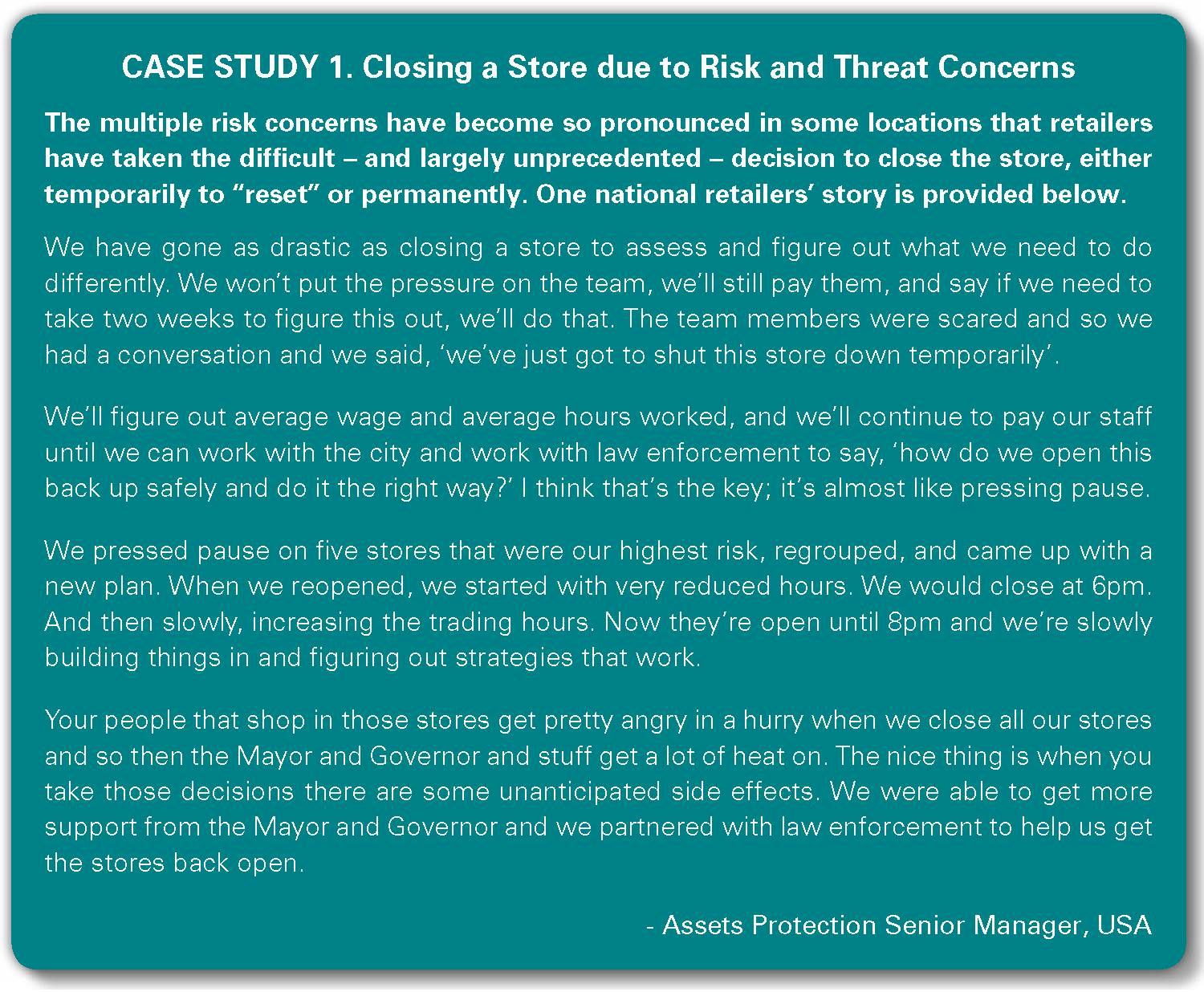
The tactics deployed as part of a control maximisation strategy are hugely variable. There is no ‘one size fits all’ approach and some techniques will be specific to the store format, local context, and the type and nature of the risks being faced. The point here is about alignment. In other words, to what extent is the business ensuring that there is alignment between the security requirements in most-at-risk stores and other parts of the business such as merchandising, layout, and design.
4. OFFENDERS
Opportunist criminals are less likely to offend if they believe that they will be noticed, caught, or identified at a later date. Whereas repeat and prolific offenders need to be identified so they can be apprehended. Companies are using multiple approaches to collect information about their customers that could deter them from dishonest behaviour, and capture identifying features of criminals, particularly repeat offenders. Visual technologies that either capture or display the image of an offender include redeployable CCTV towers, body-worn cameras (discussed above), facial recognition, and public view monitors (PVM).
Reducing anonymity of offenders
Mobile CCTV towers are being placed in the parking lots of most-at-risk stores to protect customers and their vehicles from being targeted by thieves, to identify and respond to loitering or other antisocial behaviour, particularly after the store has closed, and to provide reassurance to staff entering or leaving the premises late at night or early in the morning. They are typically solar powered and feature 360-degree coverage.
We have camera towers in our high-risk locations where we have criminal activity in the parking lots. All our stores have fixed cameras on our rooftops, but we will add in these towers for a bit more deterrence. We can broadcast messages and we have a dozen or so different scripts that we provide to our asset protection leaders that they can leverage in certain circumstances.
(VP Asset Protection and Safety, USA)
Several of the companies participating in the research were using facial recognition software in their mostat-risk stores to identify repeat offenders. Despite some negative coverage in the media resulting in a suspension of its use, an LPM for a multinational outlined a commitment to facial recognition.
We want to use this technology, we have protocols in place, and we really value the privacy of our customers. We want to use it to make sure that our stores are safe for our team members and customers by identifying violent offenders.’
An APM for a large USA national retailer stressed that they would not be part of ‘the cutting edge’ due to the ‘many guidelines, rules, and laws’ that require navigation first. Whereas another LPM stated that ‘the technology is still not mature enough.’ The legal framework in several countries does not currently permit the use of facial recognition. In markets where it can be used, being clear on the parameters of its use is essential to achieving customer buy in. It was also suggested that referring to it as ‘facial matching’ is more accurate (since it matches against a database of known offenders) and more palatable for customers.
To give the illusion of facial recognition, some companies opted for ‘facial boxing’ instead. This is where a public view monitor (PVM) displays customers entering the store and places a visible box around their face. This gives the impression that the person has been noticed entering the store and could be tracked.
We’re not there with facial recognition yet but facial boxing is enough to make the customer think twice and try to deter criminal behaviour because they think we’ve got their face and can find out who they are.
(Security Services Manager, UK)
Signalling to potential thieves that they might be being watched (and possibly recorded), public view monitors (PVM) are being used at self-service checkout podiums and on high-shrink aisles to add additional surveillance. Retailers are using a range of different devices including enhanced public view monitors (ePVM) that display signs such as ‘Recording in Progress’ and interactive public view (IPV) monitors which can stream live video feed as well as show announcements, advertisements and videos. Some PVMs are integrated with an EAS system which automates the recording of images of people who might be leaving the store with stolen items. It can also be programmed to display a message on the screen.
Some retailers have installed ANPR (Automatic Number Plate Recognition) cameras at the entrance of their most-at-risk stores to help detect, deter, and disrupt criminal activity. As a vehicle passes an ANPR camera, its registration number is read and instantly checked against a database of vehicles of interest. ANPR was referred to as being of particular value for identifying travelling criminals who might visit multiples stores across the country as well as those who use the parking lot to target customers and steal valuables from vehicles without entering the store.
Automating threat detection
Companies are taking steps to gain as much notice as possible if those with criminal intent are approaching their store or are already on site. This takes the form of visual surveillance technologies including CCTV, ANPR and facial recognition (discussed above). The threat detection is automated by triggering an alert when a match is made i.e., a car registration plate matches, or a facial image matches one in the database of known offenders. Partnership work (discussed in Joining Forces) was also a key part of this strategy to facilitate the sharing of known criminal networks, prolific offenders, and emerging threats.
Real-time video analytics are also being used at self-service checkouts to detect the nonscanning of items (e.g. bypassing scanning and placing item in the basket or under barcoding). When an incident is identified the screen can either show a text based message to the customer to correct themselves or request assistance. Some schemes will play back a short video of the action that triggered the alert. This works to a) educate the honest customer about unintentional behaviours and b) highlight to dishonest customers that their behaviour has been identified and is being monitored.
If the machine detects something wrong, we offer to help them with scanning, we ask if we can help. We never accuse them of trying to steal. We just always offer to help them – kill them with kindness – and then most people pay and leave.
(Store Associate, the Netherlands)
We use an AI-based product to identify if a customer doesn’t scan the right item or fails to scan an item and it’ll capture that information and then it relays it to the AP team and shows them the video so that we can hopefully eliminate that shrink. And it’s in the moment. So, if, for example, a customer comes up and they put a bunch of bananas on there that weighs a pound and they’re 89 cents, and then they have a ribeye steak or a filet mignon that’s probably 15 to $20 a pound depending on the cut. They weigh the bananas, and they put the steaks on the scale, the scale doesn’t know the difference. But the video would say, ‘that item that you put on the scale, and you said it was bananas, it’s red, and bananas aren’t red, so we know that’s not it.’ And it will stop them in the moment and say, ‘please remove the item and scan again’, and give the customer the opportunity to do the right thing. If they have several failures in doing that it will cause the light to come on resulting in one of the associates to come over and assist. It also detects ‘sliding’, so if you take that ribeye and you just go around the scale and put it on the weights and measure, your weights and measures will be off, and it will stop the transaction and call someone over.
(AP Manager, USA)
We are hoping to use new technologies and software to automatically generate suspicious events. These will then be under the control of the remote surveillance centre.
(Head of Security, Czechia)
Behavioural analytics such as gait and gesture recognition are also being utilised. Mostly observed in the USA, AI-powered software is being integrated into CCTV security systems to identify potentially violent intentions and behaviour. For example, software that can identify firearms and / or the movement of drawing and aiming a gun or read people’s expressions to detect aggression.
Most retailers require customers to use a loyalty card when using self-scanning technology. This was the case for all ‘scan and go’ technologies observed, and less frequent for self-service checkout kiosks. This enables ongoing monitoring of the accuracy of transactions and the ability to adjust, either manually or automatically, the frequency of audits. Partial rescan audits are the most deployed intervention to identify inaccuracies with self-scanning technologies such as ‘scan and go’ (consumer provided with a device to scan items they wish to purchase) and mobile SCO (customer uses own handheld device). Many retailers described a process whereby they would ‘force’ a rescan based on directly observed behaviour, but the default was an AI algorithm-driven audit selection that utilised previous scanning accuracy (and the outcome of previous audits) to determine the frequency of checks.
At the staffed checkouts, some companies have invested in technology that can detect and recognise items that have been left in the shopping cart or ‘bottom of the buggy’ (known as “BOB” in some locations) where large items might have been placed. The software automatically adds these items to the transaction.
We deploy a product that has a camera at the bottom of the register that looks under the bottom of the buggy. In the grocery business, you know that customers will buy things like a pallet of some water or dog food, some big-ticket items. Or paper towels or toilet paper and throw it on the bottom of their buggy. And when they get to the point of sale the cashier can’t see the bottom of the buggy, they only see what’s in the basket, and that item gets missed. So, there is a camera solution that’s underneath the register that’s specifically looking for that. It’s a very expensive product, but some brands have it in every single store. They cost justified and they believe it works.
(AP Manager, USA)
In response to loitering and anti-social behaviour (ASB), motion-detection devices are being used, particularly out of hours, and when activated typically trigger a range of responses that initially include warnings to vacate the area in the form of flashing lights and the broadcasting of automated messages. If the individual doesn’t leave the area, the retailer will receive a notification and decide whether to dispatch security or request a police response. Retailers are also using audio devices that emit sounds that are either uncomfortable to listen to (such as construction noise or high frequency sound (some of which is only audible to young people due to naturally occurring age-related hearing loss) or play music that is thought to be irritating to the individual or groups.
As with the use of facial recognition software, there is a need to carefully consider the customer tolerance for automated threat detection (particularly systems that analyse an individual’s personal characteristics), understand the limitations of the technology (e.g. the propensity for false positives), and how to most effectively leverage it.
Increasing effort and benefit denial
Increasing the effort that offenders need to go to is a well-versed aspect of situational crime prevention. There were many examples of this in relation to high-risk stores. This included target hardening the store with bullet proof materials, wheel locks on shopping carts, and smart shelves.
Retailers are installing bullet- and impact-resistant glazing in their most-at-risk stores. This was primarily for two reasons: first to discourage and thwart theft and robbery attempts, and secondly to ensure that any broken glass doesn’t shatter which could cause injury and result in liability claims. The glass still breaks and so requires replacing which can be costly but retailers using this product were convinced it was worth the ROI for the incidents it prevented. Furthermore, when the windows are broken, one AP Manager reported that the company had taken the decision not to board up the window, but rather use advertising cladding until it could be fixed:
When windows get smashed, they’re not boarded up; we use an attractive design with advertising so it’s not noticeable to the general passer-by.
(AP Manager, USA)
These ‘impressions of control’ techniques are a core part of loss prevention strategies and relate, more broadly, to the Broken Windows theory whereby visual signs of disorder propel further incidents.
In store, there are many different types of shelving and display units being used to restrict the ability of thieves to quickly sweep multiple items from standard hooks including slow motion product pusher mechanisms, pegboard hook locks, and anti-theft helix hooks. There was also a move towards automated alerts if more than a certain number of items was removed in quick succession. This had mixed responses depending on how it was being deployed. If the alert triggered an automated response such as a flashing light, audible sound, or focused a camera on the area this was typically welcomed by store associates. However, some were less favourable if it prompted an individualised alert that required them to investigate.
They (thieves) quickly learn about the alert, and they turn it to benefit themselves. They know I must go and see what’s happening in the aisle. At that moment their accomplice is stealing something else. I can’t be everywhere all the time.
(Store Associate, the Netherlands)
There are a range of shopping cart containment devices aimed at restricting the movement of shopping carts outside of predetermined zones. Some solutions have a device that ‘locks’ one wheel if there is an attempt to push the cart out of the permitted zone. The wheel lock is activated by a sensor that is embedded in the floor. Some have added two locking wheels to prevent the more determined from lifting the locked wheel off the ground. Retailers reported using increasingly customised zones for the containment of their trollies, including having sensors to lock carts if they haven’t passed through the checkout area.
Tags that impact negatively on the product when the thief tries to remove it are not new but are taking on new designs to make a broader range of merchandise unusable and/or difficult to resell. One of the most common ‘benefit denial’ tags is ink tags which release indelible ink when the tag is tampered with. Some companies were also using benefit denial tags on alcohol bottles to make it very difficult to open the bottle without breaking it. As one store associate commented about an expensive bottle of wine with a bottle top tag, “you can’t gift that or bring it out to a dinner table, can you?”
To further deny benefits to the offender, companies are using forensic asset tagging or other means of identifying their stolen stock in a bid to disrupt sales. Stickers or stamps are placed on items that are often stolen in bulk by organised criminals intended for resale. The marker has the store code and date on with a contact number to call. The stickers were difficult to remove and would leave a residue on the product impacting on its resale value and desirability. Some companies had invested in more high-tech solutions such as liquids with a unique identifier that are applied to pallets of high-risk goods.
5. GUARDING
Guarding is often the default solution deployed to tackle in-store security and risks. So much so, it was not uncommon for participants to describe a store’s risk level in terms of the number of guarding hours or coverage that it had. Yet guarding is expensive, and not always the right standalone decision. Furthermore, there is a shortage of qualified and trained security guards in many countries. There are many reasons for this including the cost of training and licensing, as well as the increase in abuse and violence suffered by security officers in public facing roles.
Breaking away from the traditional security guard provision, there are some new and innovative approaches to guarding being used in most-at-risk stores. This includes employing community outreach workers to assist those with social issues who are causing problems, partnering with non-profits to provide a community focused security provision, employing off-duty police officers, and remote monitoring the most-at-risk stores from a dedicated security centre with highly trained operatives. There were also fixed deployments and roaming guards (visiting multiple stores while on duty and being on call to quickly respond to incidents).
Community and outreach workers
Several companies are taking a more community oriented approach to guarding by engaging with the non-profit sector and recruiting outreach workers. For example, in the USA, one of the companies participating in this project had partnered with a non-profit to provide Community Outreach guards in place of traditional security. There were many reported benefits of this model for both the business and the community. The programme provided employment and mentoring opportunities to the local community, diverted individuals from the criminal justice system and enabled vulnerable individuals to build rapport with the Community Outreach guards. While providing a form of security function, individuals are specifically trained to identify and signpost vulnerable individuals (those experiencing homelessness, drug and alcohol-affected individuals, or those displaying mental health concerns) to help and support.
We hire heavily from people that have backgrounds in counselling or experience of working with people with mental illness. And they help these folks. So, if a homeless person comes in and they’re just trying to steal a pair of socks, they’re the ones that will actually give them the pair of socks, clothe them, tell them how to get resources, show them where shelters are, and help them through that process. It’s gone so well that in one location, an encampment that had over 100 transient and homeless folks, has been cleared. They were coming into the store only to ask “we hear you know where we can go and get help?” They were only coming in to steal bars of soap to get clean or that kind of stuff. They’re not coming in to boost. And so, by employing people to help with that piece; the mental illness, the homelessness, we’re seeing incredible successes to the point that we’re expanding to more markets right now. It’s an extension of our store into our communities and that’s good to see.
(AP Senior Manager, USA)
Having identified a disconnect at times between externally provided security guards and internal staff, one European multinational has implemented a hybrid model whereby individuals are trained to fulfil both the guarding function and work as a cashier. The Chief Safety Officer of the company outlines the three levels to their guarding approach below.
We have guards that work as cashiers. So, they are at the same time security guards and cashiers. They mainly do store work – 90% or 95% of their time is store work, but they have full security guard capabilities to react if it’s necessary. It’s cost saving, and of course it means that we can have guards in some stores that wouldn’t otherwise have their own personal security guard. Then we have security guards that are fully focused on the security guarding issues in the stores that have lots of action. They have constant security problems, so we need a security guard there to be present all the time. And then we have a model in between those, or a little bit closer to the security guard. We see them as a kind of ‘service guard’ that can do assistant store work, about 30% of his time or her time on those issues. It’s cost-efficient for stores to have those.
(Chief Safety Officer, Finland)
Several of the hybrid staff took part in informal interviews as part of the store visits. Overall, they described feeling much more embedded in the company because of their dual functionality. They felt more integrated with the store team, rather than an “add on” and reported that this improved communication about security issues. Other staff members were positive about the hybrid roles. They liked the additional security functionality which provided reassurance, but they also welcomed the customer service support, particularly if a customer was becoming aggressive.
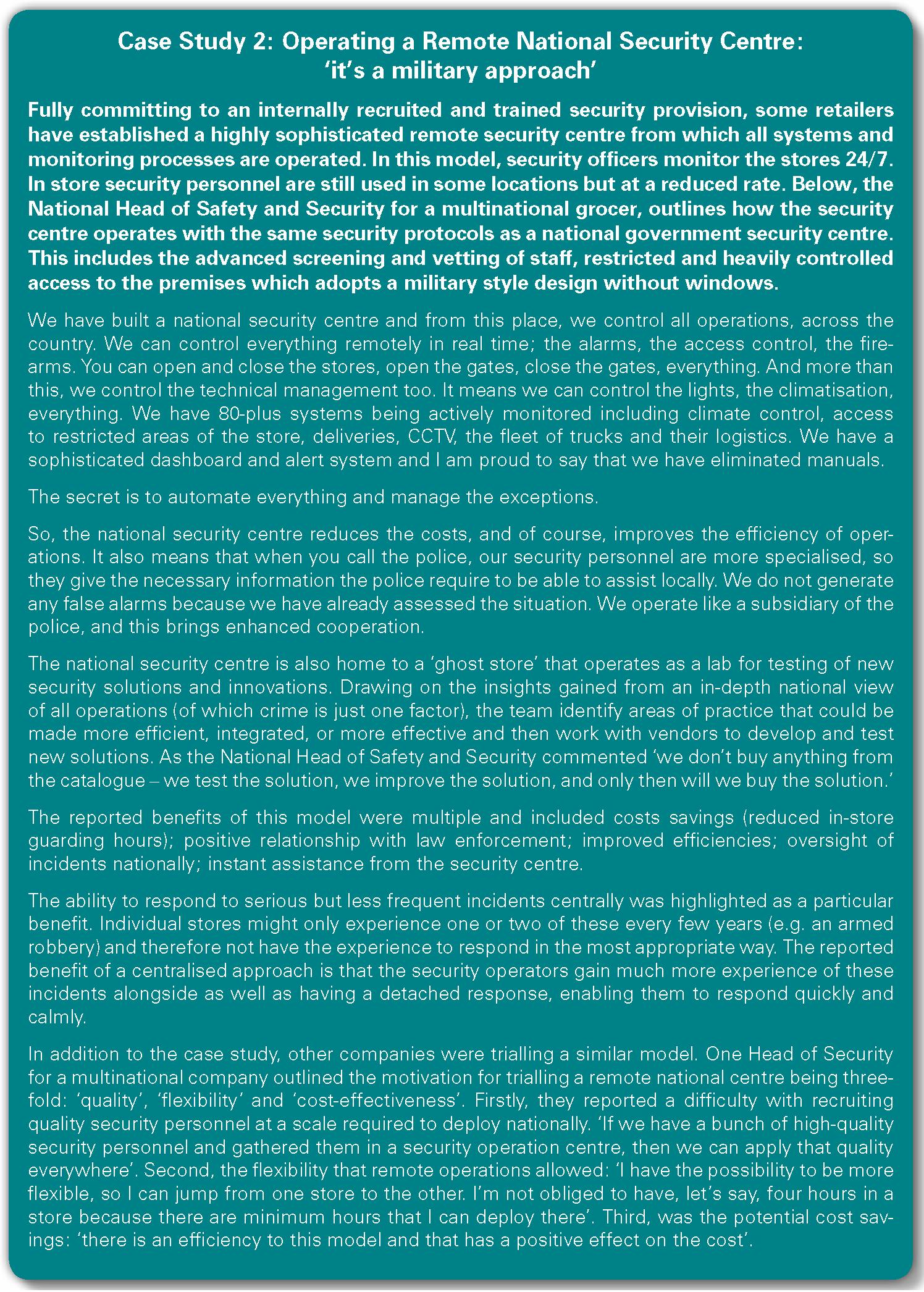
Guarding strategies that have evolved beyond a simple calculation of the number of contracted hours for outsourced provision were reportedly showing good results. However, it was highlighted in some of the interviews that changing a guarding strategy had implications for liability claims.
Removing a security guard can be difficult, because once you identify a store as needing security guards, then the moment that you reduce, change or eliminate that security coverage, if an event happens there’s going to be a liability issue; ‘you put the guard there, now you’ve taken the guard away and as a result someone came into the store and shot my son or daughter, and I’m holding you liable because you knew it was a risk.’ Now you have to prove the justification for removing the guard. I’m not going to say that you can never remove guards, just that you need hard, fast evidence to support that decision.
(AP Manager, USA)
There is huge variation in how businesses are innovating and changing their guarding model. As above, it is not about deploying a specific approach but rather it is about accepting that the provision in most-at-risk stores needs to be thought about differently, aligning the guarding approach with the local context and risk environment, and taking concrete actions (in relation to training, technology, personnel) to mitigate risk in those stores that have pronounced challenges.
6. MONITORING
Businesses need to centrally design the security strategy for most-at-risk stores and communicate it throughout the company. Store associates and managers deploying their own tactics introduces its own set of risks. Yet, following the implementation of a risk mitigation strategy or solution, some businesses reported that ongoing monitoring is minimal to non-existent since any evaluation would only add to the cost. At a minimum regular in-person checks should be made to ascertain if store associates are introducing workarounds to the ‘solution’ that has been introduced or if there are other types of implementation failure taking place e.g., body-worn cameras and headsets not being charged.
You can have all the gear but no idea. You can have all this fancy equipment but if you don’t know how to use it or you’re not using it in the right way, it’s a waste of money. A lot of my work currently is about providing guidance and training to our shops, so they understand the ‘why’ behind the ‘what’. So why do I need to do that? What issue is that solving? We need to do better at educating our colleagues on what the right thing is to do is and, importantly, why.
(Head of Security, UK)
On the store visits undertaken as part of this study, just some of the things observed included placing a bucket of receipts next to self-service checkout gates so that customers could scan them to exit, propping entrance gates open, disabling EAS alarms, leaving frequently accessed security cabinets unlocked, and only tagging a small number of on-shelf bottles of liquor because there were not enough tags in circulation. The store visits also revealed a high instance of staff members assigned to wear a body-worn camera not doing so. The reasons that were given ranged from it being ‘on charge’, broken, forgetting to use it, or being in too much of a hurry. Some staff also reported that there were times when they didn’t activate the camera during an incident because they were worried that it might make things worse. This can have a big impact on effectiveness.
We found that the stores that were more compliant in wearing the body cameras were not only seeing an impact on their violent incidents, but it was also improving their losses. That was a big change that we didn’t expect to see but it’s difficult to know if it will be sustained.
(Head of Security, UK)
In a similar vein, it is important to monitor if store associates are introducing their own ‘hacks’ or ways of doing things to reduce crime in store. For example, some store members were using personal instant messaging services (in the absence of a store provided system) which presents issues relating to privacy and data protection laws and the secure management and processing of personal data. It does, however, highlight a need for systems such as tablets and hand-held devices that can quickly (and safely) share information internally and, where appropriate and required, externally with the police and/or other businesses. Similarly, in another store, associates had attached a large heavy metal chain across the entrance to a high theft aisle so that they could hear customers enter the area.
As with the importance of data outlined above, ensuring that there is clear and readily available information on what is happening in store is crucial to tackling high levels of crime, abuse and social issues that impact on the store. Staff need to be motivated to report, particularly when crime is high volume and takes up considerable time. Monitoring the impact and sharing ‘good news’ stories can help to energize employees.
7. JOINING FORCES
The bulk of the above strategies focus on what is happening within a business’s own four walls or in the immediate vicinity of the store. But there are also strategies that involve broader layers of defence. A notable trend in the highest-risk retail stores, was a recognition that partnership work – with other stores in the area, with law enforcement, and the community - could assist in tackling threat and vulnerability priorities. Partnerships were either formalised e.g., with information sharing agreements or the payment of a levy into a shared fund, or informal.
Organised Retail Crime Associations (ORCAs) are partnerships between law enforcement, retailers and security professionals to stop or disrupt illicit ORC networks from committing crimes. ORCAs focus on criminal enterprises and although there is some variation in scope, size and mission, they typically aim to achieve some or all of the following:
- develop new and innovative ways to combat property related crime
- educate the public on the problems associated with crime
- utilise advance technology to enhance the sharing of information to members
- hold training events to educate law enforcement and the private sector regarding current and emerging crime trends
- encourage members to meet regularly and share high level intelligence with one another
- unite businesses, local government/city officials, and law enforcement in a plan to reduce crime and create safer areas to live, work, and shop
There are currently approximately 50 ORCAs operating across the USA.
Using a similar public private partnership (PPP) model, in the UK, Business Crime Reduction Partnerships (BCRPs) operate to reduce business related crimes on a geographical basis. A BCRP is a subscription-based, business-led, non-profit making action group working with police and the local authority to tackle and reduce crime and disorder affecting businesses. They have huge potential to drive communication and collaboration between the police, local businesses and local authorities on crime-related issues that directly impact on business as well as the surrounding areas more broadly. There are thought to be in the region of 250 BCRPs in operation across the UK. They range in size from small schemes operating in towns to larger city-wide operations with several staff and hundreds of members.
The ‘Offender to Rehab’ (O2R) programme was established by West Midlands Police in the UK to target prolific shop thieves who are offending to fund substance misuse. The programme identifies known thieves and supports their journey into rehabilitation with the aim of addressing the root causes of their criminal behaviour. The funding for the programme is provided by businesses and money seised from criminals, under the Proceeds of Crime Act.
There were also many examples of targeted action initiatives taking place that being businesses, law enforcement and communities together to tackle shared issues and raise awareness. In the Netherlands, for example, businesses hold a Week of Safety in partnership with the government and police to tackle specific priority issues.
Week 41 is designated the Week of Safety when we talk about the police, the government, retail, hotels, restaurants, bars, etc. They always talk about the same topic, how to be safe. And it can be about creating a prevention plan for robbery or focusing on aggression. Sometimes it’s about cybercrime and different kinds of safety, but nevertheless we use those topics to pay attention nationwide on these issues.
(Security Manager, the Netherlands)
Similarly, Safer Business Action Days (SaBA) (UK) is a joint approach by the police, business, private security working in partnership to focus resources into a designated location to tackle problem activities. Safety campaigns have also been supported by retailers seeing high levels of threat, such as the #ShopKind campaign which aims to tackle violence and abuse towards store associates.
There are also initiatives where retailers and government agencies work together to deliver community programmes in schools.
We are participating in these community programmes to educate the youth in schools about why you shouldn’t steal. Because quite often the first criminal act is shop theft, and then they get onto the more serious crimes later, often related to drugs. All the retail sector in Finland participates together as part of our corporate social responsibility. We have an organisation that goes into schools, and they also teach them responsibility, financial knowledge, how to handle your own money and everything. One of the modules is on ethics and good behaviour and we have funded a virtual exercise where they are making choices in the store. There’s a very famous YouTube person there giving them the right knowledge, that you should do this and not do this, and what will your friends think about this, and parents think. It’s been really good.
(Chief Safety Officer, Finland)
Don’t be a Leaf Blower!
On one of the European country store visits, I had spent the morning touring stores with the company hosts when we stopped for lunch. We sat outside a row of businesses including cafés and shops. It was a busy capital city and there was litter on the street. We observed as one of the managers of a café used a leaf blower to move the rubbish from immediately outside his premises. But in doing so he simply shifted it to the neighbouring businesses. The same can apply to security – stores need to focus on resolving problems together rather than pushing it onto other businesses in the vicinity.
Conclusions, Limitations and Next Steps
This research project has been truly multinational, involving participation from 11 countries and in-person visits to six. The findings have enabled the context of what retailers are experiencing in some locations to be brought to life with real-world experiences and tangible examples. Relatedly, the solutions, tactics and strategies that have been deployed are many and varied. This nuance could not have been captured without seeing them in situ and talking at length with the store associates who are tasked with securing the store in which they work. There is universal acceptance that in-store security is incredibly challenging in some locations and that businesses need to collaborate with one another, as well as work in partnership with law enforcement, government, non-profits and the community in these areas.
Limitations
As with every project there are always limitations. For this particular study, it was beyond the remit to evaluate the tactics and solutions being deployed. They are presented as an overview of how most-at-risk stores are responding to multiple threats and vulnerabilities, but this should not be read as endorsement. Furthermore, the legal framework across countries (and even within some countries) is hugely varied. This is particularly pronounced for audiovisual technologies such as facial recognition, CCTV, and body-worn cameras.
Similarly, the study did not explore the relative effectiveness of law enforcement and criminal justice policies and practice. There was a broad dissatisfaction with the police response to crime and a general frustration that the same known offenders were often repeatedly targeting stores with little recourse. There is more that needs to be done to understand what an effective criminal justice approach to crimes committed in the retail sector should look like. This would include pathways into service provision and support for repeat offenders who are committing crimes due to substance misuse, homelessness, and/or mental health issues, as well as a commitment to more robust sanctions for those exploiting vulnerable others to operate criminal enterprises.
Future Research
When devising the risk mitigation wheel, there were originally only six categories. Data was not a standalone category because it is so integral to every aspect of operation; monitoring interventions, knowing who your staff are, knowing your offender profile, being able to share intelligence on prolific criminals with the police and other businesses. However, I was concerned that its prominence would be lost if it was not singled out as a standalone factor. It should be recognised that every segment on the wheel starts with a need for reliable data. To that end, in terms of next steps and further research, there are fruitful avenues to pursue.
Participants in this study described concerns about the validity, reliability, and timeliness of data, both internal and external, that could undermine effective and timely decision-making. In addition, some felt that there was not enough understanding about which variables had the strongest explanatory or predictive power, how to effectively weight variables (i.e. weighting high-risk/low-frequency incidents such as armed robbery compared to low-risk/high-volume incidents such as theft), and how to control for variables such as store format (e.g. convenience, large format, petrol filling station shops, acquisitions/purpose built, etc.). Further research with this focus could be hugely valuable to the industry.
It is also apparent that there are very different definitions and understandings of what constitutes ‘organised retail crime’. It is important for retailers to have a shared definition of ORC (or at least be aware that it is so variable) and how it manifests if it is to be effectively targeted and disrupted.
Overall, it is hoped that the research presented in this report is useful to those tasked with protecting staff, reducing losses, and creating a safe and enjoyable space to work and shop. There were some stand out approaches being adopted and it was clear that this was only possible when innovative and pioneering Heads of Security/LP/AP were working within a business that was willing to break the mould and accept that most-at-risk stores need a different approach to the rest of the business. It is hoped that the context provided in this report will support some of the difficult conversations currently taking place across the industry.
Next Steps
The Most-at-risk Stores Benchmarking Tool can be found on page 45. Businesses are encouraged to complete the tool by responding to a set of four statements for each of the 7 key strategic principles. The questions relate to the degree of awareness, acceptance, alignment, and commitment to act on issues experienced in most-at-risk stores. The benchmark will provide a score across those four domains for each category (data, people, control, offenders, guarding, monitoring, and joining forces), to provide clear insight to what aspects are working well and which require further attention.
It is anticipated that Loss Prevention teams first complete the benchmarking tool to establish an aggregated score and then explore any outliers in more depth. It might then be useful to share the tool with the different functions in the business (e.g., marketing, merchants, store design, format layout, Human Resources, and Information Technology) to explore how the scores vary between them. Finally, a third stage could be for the senior leadership team to complete it (e.g., the Board or the executive committee). At each of these different levels of the business it is anticipated that the process of scoring and then discussing the results will bring to light any gaps, barriers and opportunities to evolve risk mitigation strategies in most-at-risk stores.
5. UPDATED: Most at-Risk Stores Benchmarking Tool
Welcome to the UPDATED: Most at-Risk Stores Benchmarking Tool. Detailed below a series of statements relating to the 7 key strategic principles of the risk mitigation wheel. Using the scale 0-3 outlined below please rank your business’ performance against each of the statements. For step-by-step guidance on how to complete the benchmarking exercise, please see the accompanying document ‘Most at-Risk Stores: How to Engage Others in a Cross-Function Risk Mitigation Strategy’. It is available to download on the ECR Loss website. Or contact colin@ecrloss.com.
Try to get other functions within your business to complete the scorecard as this will give you a better understanding of how they view the current level of risk mitigation in your most-at-risk stores. But first, it is suggested that Loss Prevention teams complete the benchmarking tool to establish an aggregated score and then explore any outliers in more depth. It might then be useful to share the tool with the different functions in the business (e.g., marketing, merchants, store design, format layout, Human Resources, and Information Technology) to explore how the scores vary between them. Finally, a third stage could be for the senior leadership team to complete it (e.g., the Board or the executive committee). At each of these different levels of the business it is anticipated that the process of scoring and then discussing the results will bring to light any gaps, barriers, and opportunities to evolve risk mitigation strategies in the most-at-risk stores.
You may find it useful to review your performance over time by completing the scorecard periodically.
• Awareness: To what extent is the business aware of the specific risks that are present?
• Acceptance: To what extent does the business accept that special measures are required to manage the heightened risks in the most at risk stores?
• Alignment: To what extent has the business shifted practice in most-at-risk stores to align with the security needs, particularly when this presents tensions with the overarching company brand and/or policy deployed elsewhere in the estate?
• Actions: To what extent is the business supporting and investing in concrete actions to mitigate risks in the most-at-risk stores?







Main office
ECR Community a.s.b.l
Upcoming Meetings
Join Our Mailing List
Subscribe© 2023 ECR Retails Loss. All Rights Reserved|Privacy Policy

